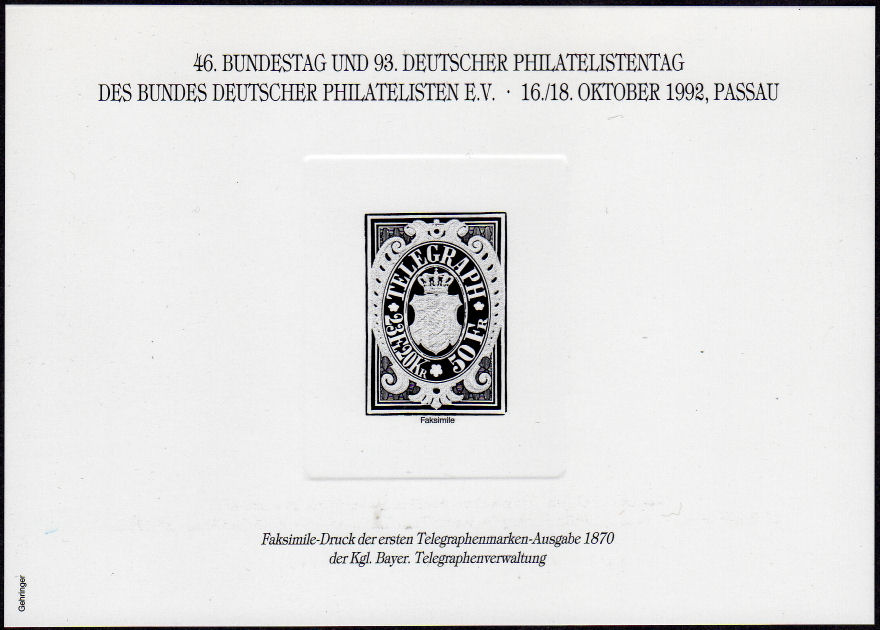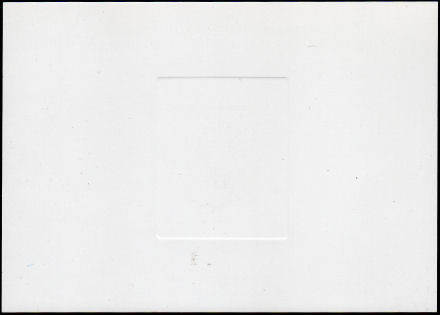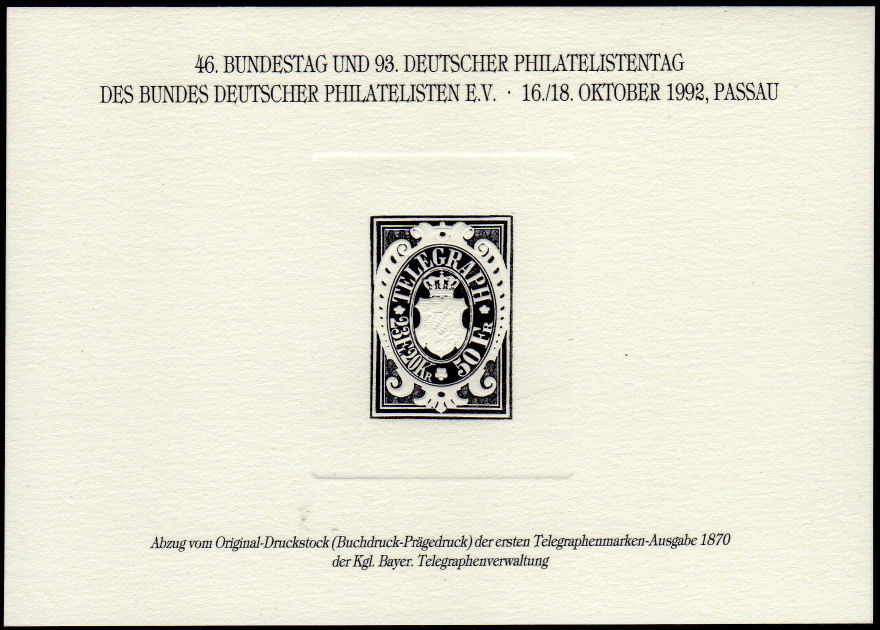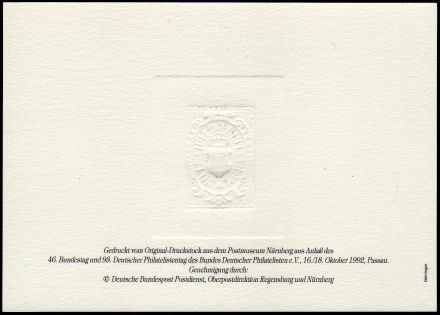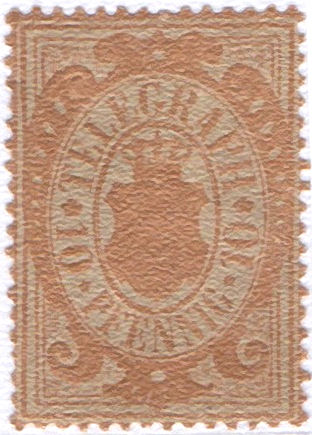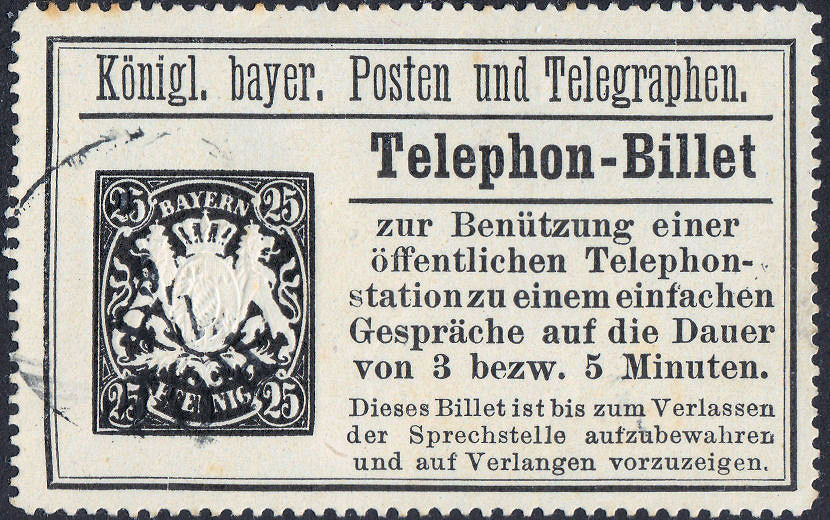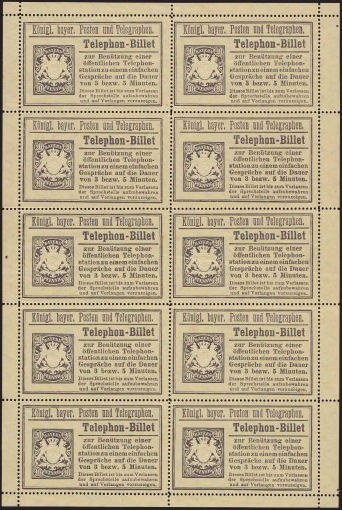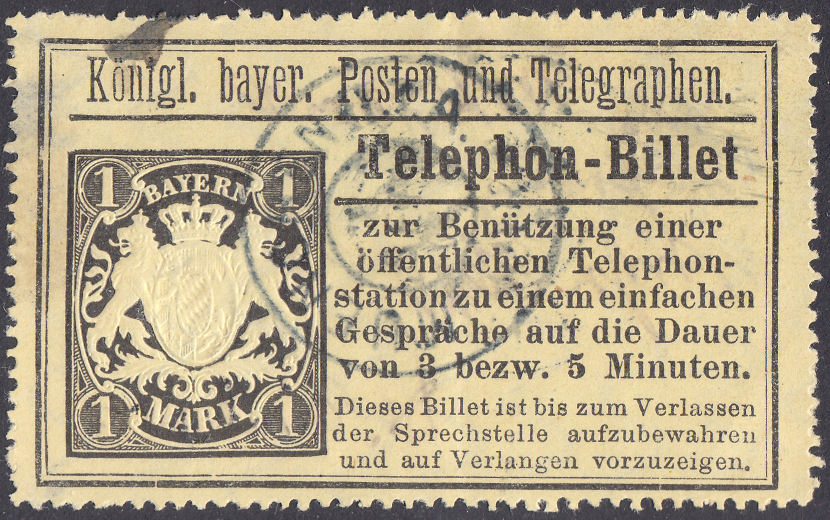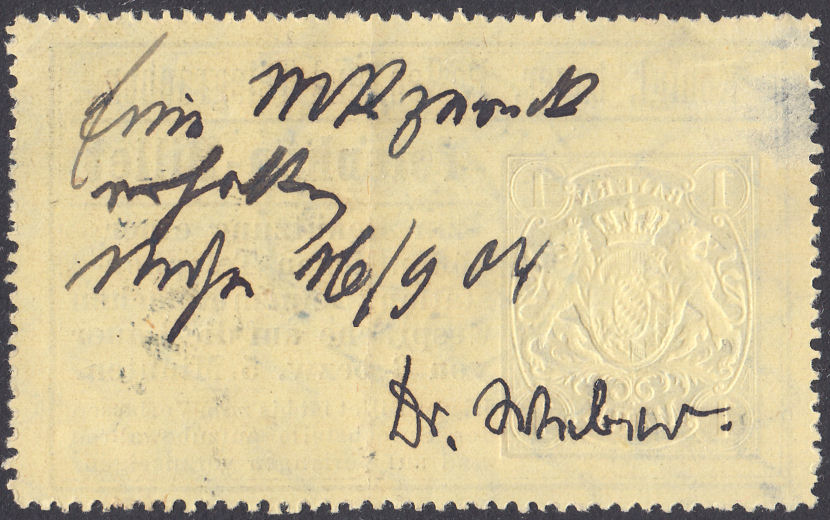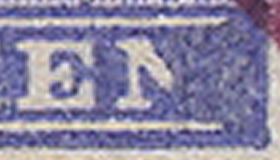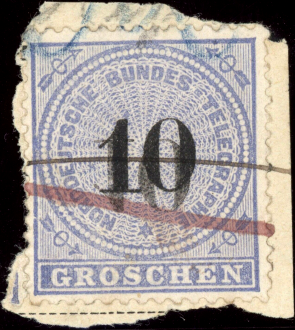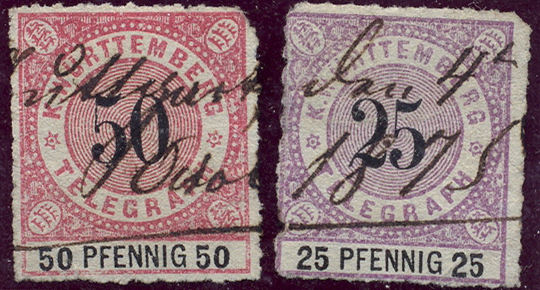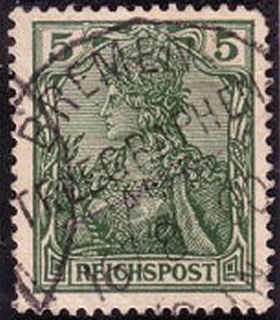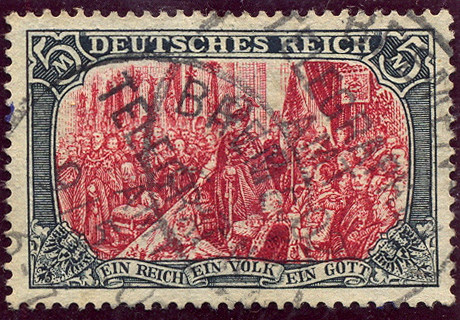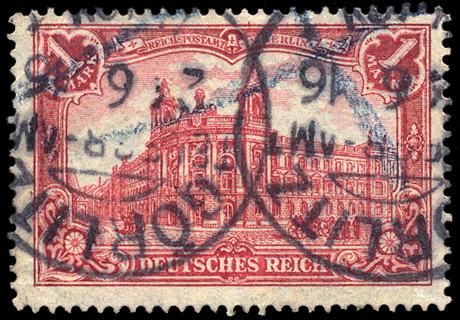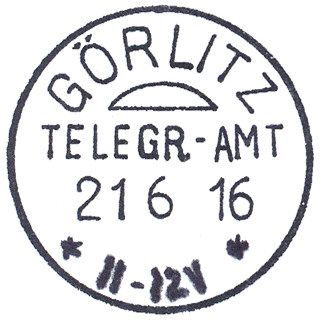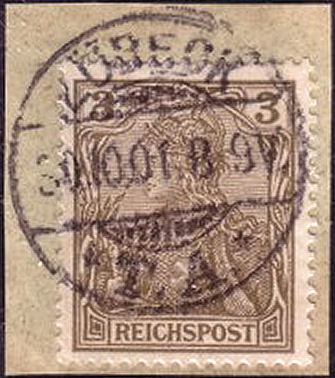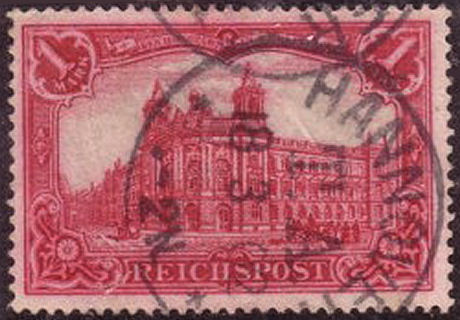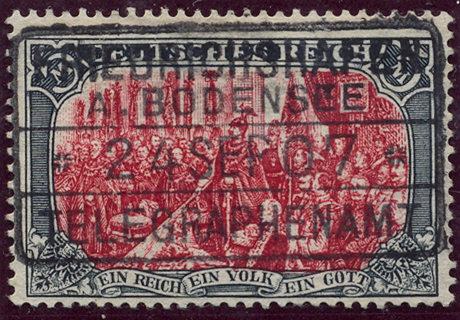| Up a level | ||||||||||
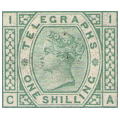 |
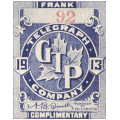 |
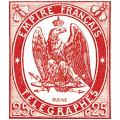 |
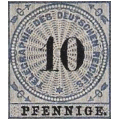 |
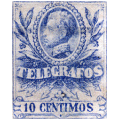 |
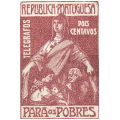 |
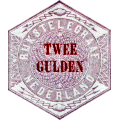 |
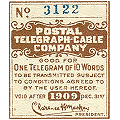 |
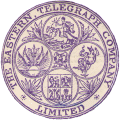 |
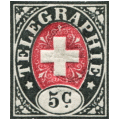 |
 |
| British | Canadian | French | German | Spanish | Portuguese | Netherlands | U.S.A. | Eastern | the rest | Contributions |
I have brought these prices up to date and added currency selection. I have used 'RH' numbers (Revised Hiscocks) for new designations to avoid confusion. CheckList Setup |
GERMANY.
Steve Hiscocks wrote in 1982:
The telegraph stamps of Germany and of the States which coalesced to form that country are straightforward but interesting in that they reflect the
political history of the period. Thus we have the stamps of Prussia in use only in Berlin (main Post Office and Stock Exchange only) from 1864 to
31 July 1869. The following day, 1 August 1869, the stamps of the North German Confederation were introduced and these were used until 31 October
1872 when they were replaced by the stamps of the German Empire (Deutches Reich). The use of these stamps was abandoned in 1876. The stamps
of Bavaria (1 January 1870 to 31 December 1880) and Wurttemberg (1 January 1875 to 30 June 1881) are independent of the Prussia to German
Empire sequence.
Cancellations will be noted in the appropriate places but it is worth noting here that the telegraph stamps of the German Empire (1873 - 1876) were
also used for postal purposes and are thus found with postal cancellations.
Bavaria also issued telephone stamps. Private issues first appeared in Munich on 5 November 1883 and in other parts of Bavaria soon afterwards.
Official telephone stamps appeared on 1 January 1891 and, with various changes, remained in use until 1908. Telephone stamps were also used
under the German Empire from about 1881 to 1891 but background information is needed.
In the following pages I have taken the states in alphabetical order followed by stamps of the German Empire.
| Shortcuts to other sections | ||||||
| Bavaria | Bavarian Telephone Stamps | North German Confederation | Prussia | Württenberg | German Empire | German Empire Telephone Stamps |
1. Bavaria.
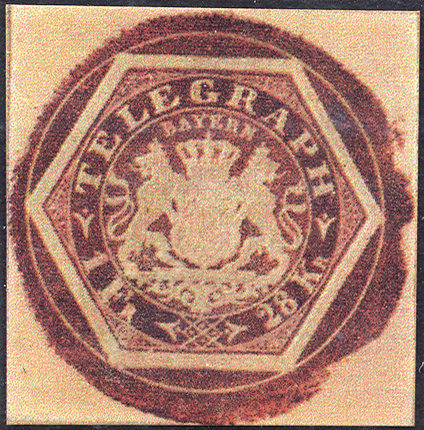
This was described as a rejected essay of 1869 by Rolf Lamprecht who supplied the image.
I. Private Telegraph Stamps.
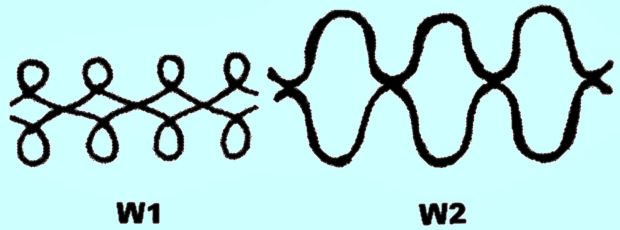
1870 (1 January) Typographed on vertically laid white paper. White areas embossed. Watermark W1, Perf. 11
Watermarks taken from pages 118/9 of Hiscocks book.
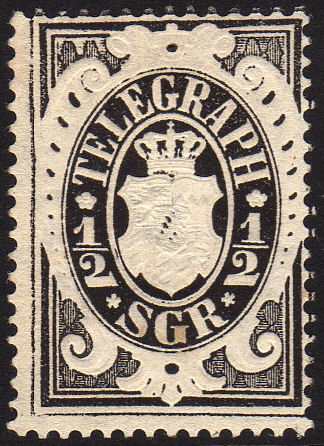 |
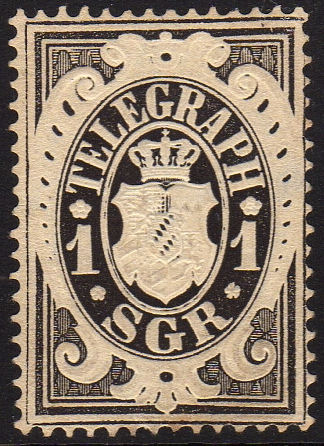 |
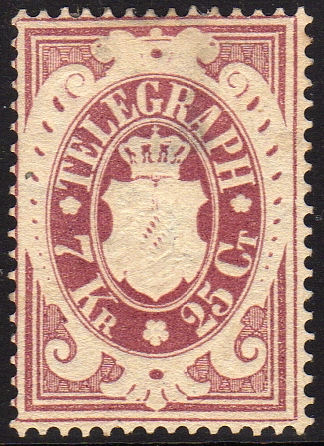 |
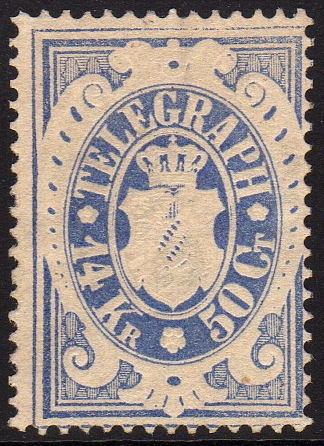 |
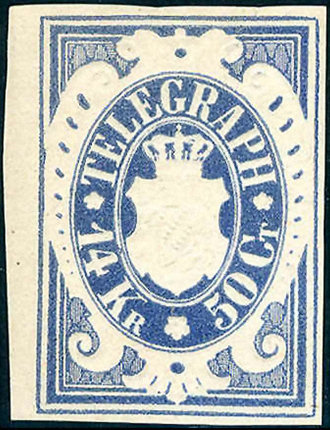 |
| H1 ½ SGR. | H2 1 SGR. | H3 7Kr / 25c. | H4 14Kr / 50c. | H4a 14Kr / 50c imperf. |
| Images courtesy of Andrew Higson. | Don't know where this came from. If yours, please get in touch. |
|||
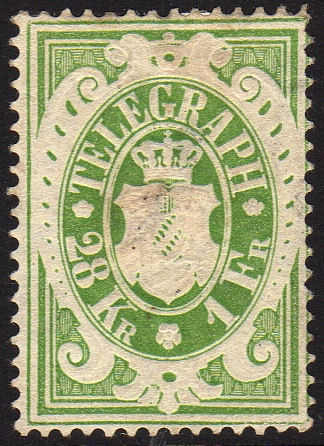 |
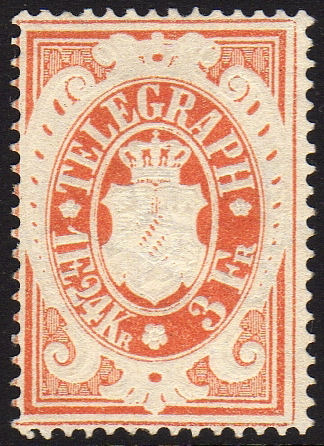 |
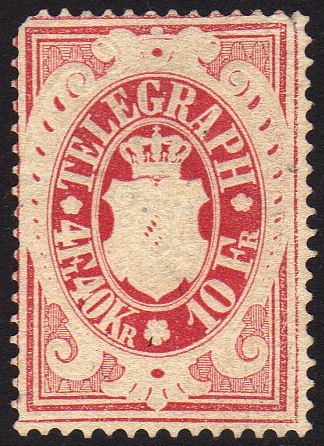 |
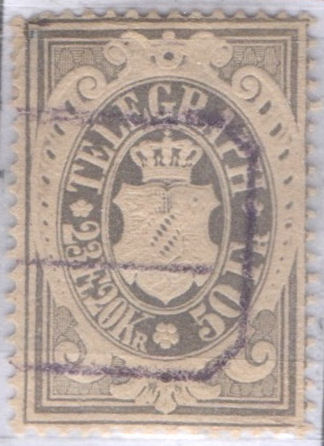 |
| H5 28Kr / 1Fr. | H6 1F.24Kr / 3Fr. | H7 4F.40Kr / 10Fr. | H8 23F.20Kr / 50Fr. |
| Images courtesy of Andrew Higson. | Image courtesy of Paul & Les Bottomley. | ||
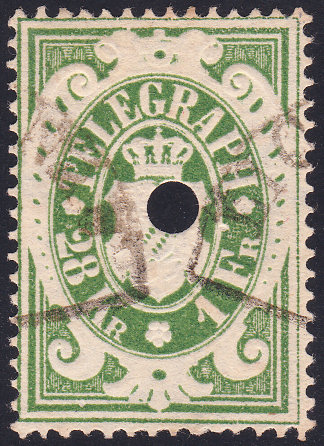 |
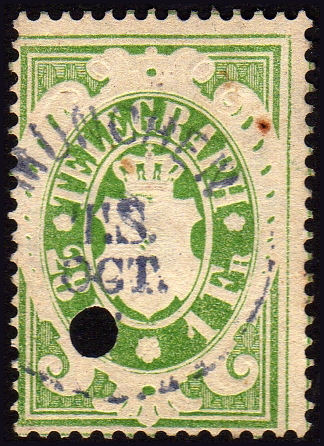 |
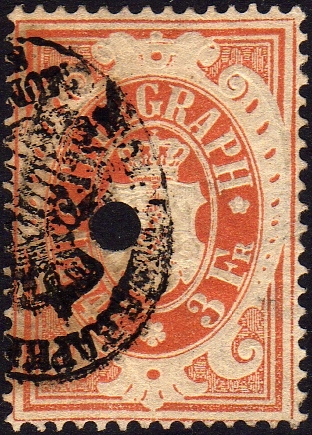 |
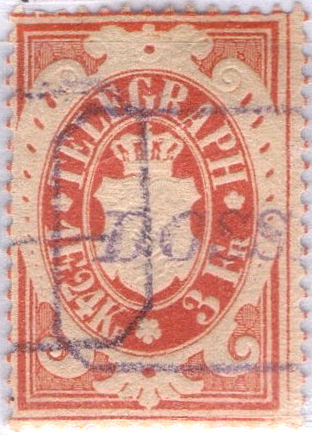 |
| H5 28Kr / 1Fr. Used | H5 28Kr / 1Fr. Used | H6 1F.24Kr / 3Fr. Used | H6 1F.24Kr / 3Fr. Used |
| One of mine. | Images courtesy of Andrew Higson. | Image courtesy of Les Bottomley. | |
| Hisc. | Description | Mint | Used |
|---|---|---|---|
| H1 | ½SGR black (1.2.72) (320,000) | 90.00 | 100.00 |
| H1a | imperf. | - | - |
| H2 | 1 SGR black (1.2.72) (3,024,000) | 120.00 | 125.00 |
| H2a | imperf. | - | - |
| H2b | on bluish paper | 150.00 | 160.00 |
| H3 | 7Kr — 25c purple (1,300,000) | 140.00 | 110.00 |
| H3a | imperf. | - | - |
| H4 | 14Kr — 50c pale blue (3,360,000) | 300.00 | 150.00 |
| H4a | imperf.. | - | - |
| H5 | 28Kr — 1Fr greyish green (2,758,400) | 450.00 | 250.00 |
| H5a | imperf. | - | - |
| H6 | 1Fl 24Kr — 3Fr orange (265,600) | 1200.00 | 900.00 |
| H6a | imperf. | - | - |
| H7 | 4Fl 40Kr — 10Fr carmine (13,800) | 1800.00 | 1800.00 |
| H7a | imperf. | - | - |
| H8 | 23Fl 2Kr — 50Fr grey (3,200) | 3000.00 | 3000.00 |
| H8a | imperf. | - | - |
Quantities printed added in brackets. H8 is shown here as equal value to H7, but in reality is much scarcer.
The Specialized Michel German catalogue (part 1, 2014) is the source of these quantities, and also states
that the top two values were not officially released to the public, but only used internally by officials.
H1 and H2 are often given the same value in catalogues. However I have 3 examples of H1 and have not even seen H2 for sale.
Hiscocks added the following 5 notes:
| Note 1. Used values are normally cancelled by punch. |
| Note 2. Imperforate specimens of all values have been reported but there is not sufficient information to set prices. They were reportedly issued some months before the perforates. |
| Note 3. The sheet consisted of two panes of 16 (4 x 4) with a gutter strip between them. Gutter pairs are very rare. |
| Note 4. Reprints of No. 5 are known. See note below No. 25. |
| Note 5. Colour trials of No. 5 are known in purple, orange, carmine and grey — the issued colours of Nos. 3, 6, 7 and 8. All are imperforate. |
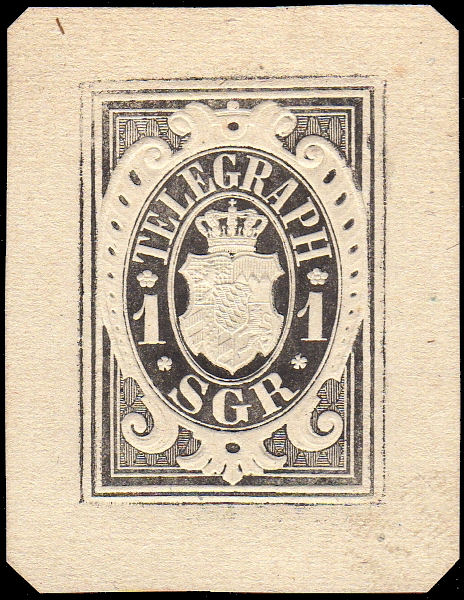 |
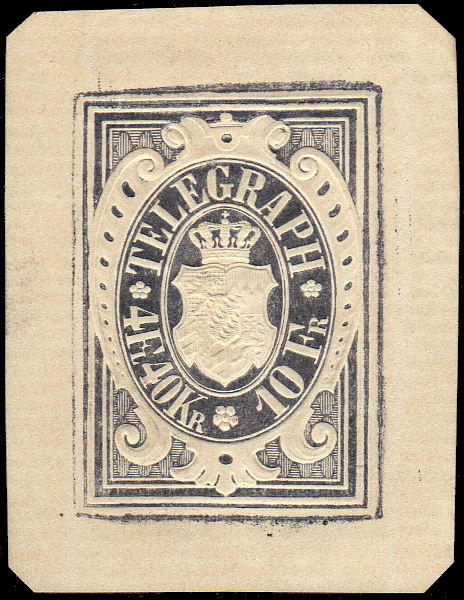 |
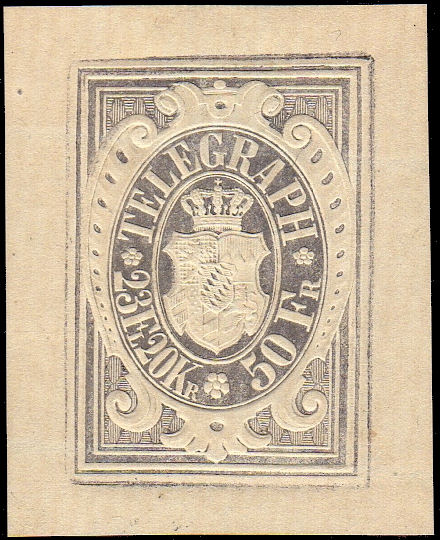 |
| H2 proof with embossing. 1 SGR. | H7 proof with embossing. 4F.40Kr / 10Fr. | H8 proof? with embossing. 23F.20Kr / 50Fr. |
| These are presumably proofs, but the first and last are in the issued colours, so if cut down they could easily be confused with the imperf. items listed by Hiscocks. (See his notes 2 & 5 above) Proofs would not be expected to have watermarks though. See also the 1992 souvenir sheets below - Images courtesy of Andrew Higson. I understand that an example of the 4F.40Kr / 10Fr above sold for €2785 at auction in 2008. |
||
Reprints (front and back, see Note 4 above).
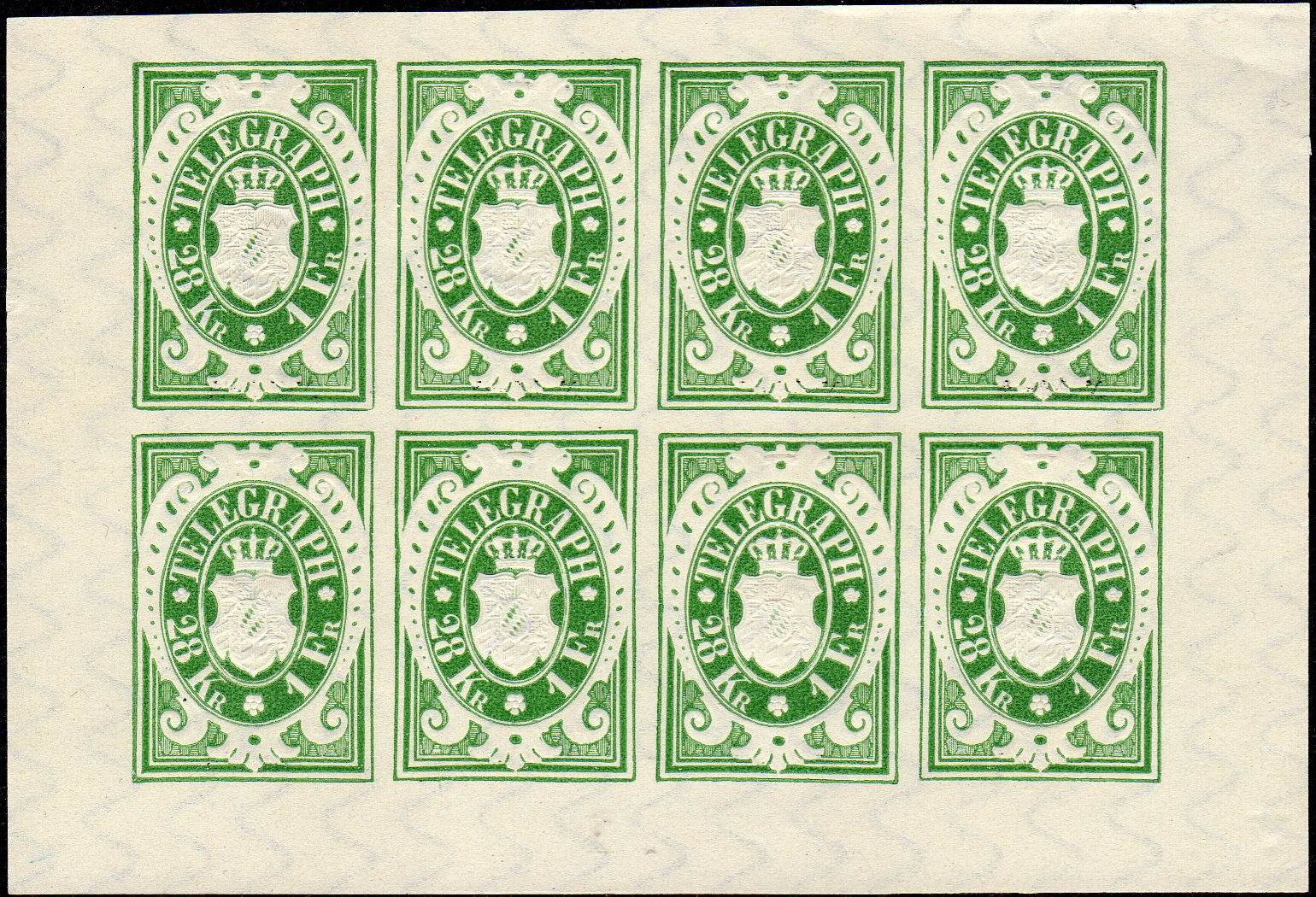
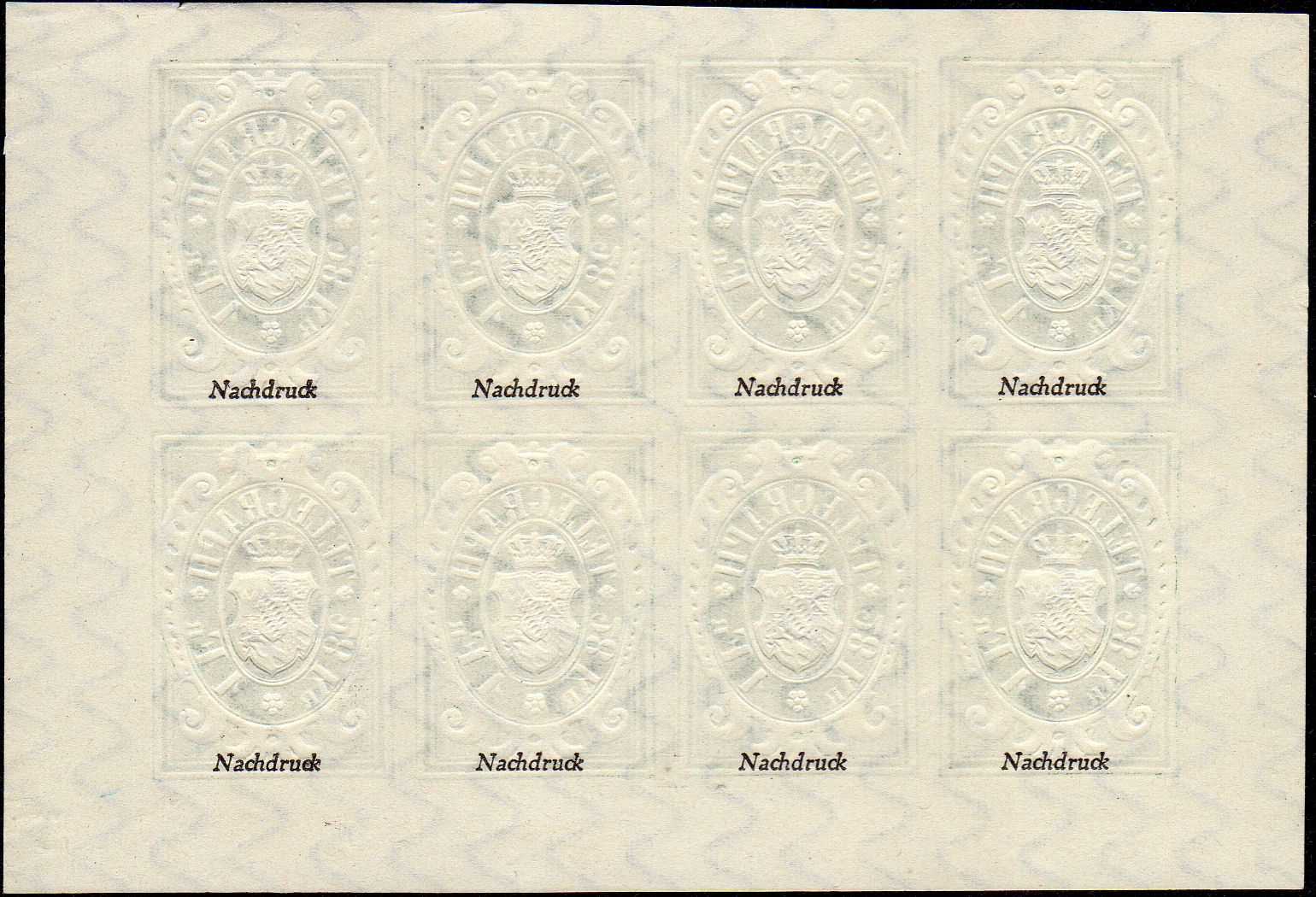
The Telephone stamp watermark (W3 below) can clearly be seen. Images courtesy of Andrew Higson.
1992 Souvenir sheets.
Two types of Exhibition sheets were produced in 1992 for a Philatelic Exhibition of October 1992 in Passau, Bavaria.
One is on thin white paper with printed embossing and the word 'Faksimile' underneath and nothing on the back.
The other is on thick cream paper genuinely embossed from the original die without 'Faksimile', with a write-up on the back.
Both are printed in black rather than the issued grey colour. Beware of 'modified' versions sold as originals !
The images below are half size for the front an quarter size for the back.
They come courtesy of Andrew Higson.
1876 (1 January) Same design and watermark, but currency changed to 100 Pfennig = 1 Mark. laid paper. Perf. 11
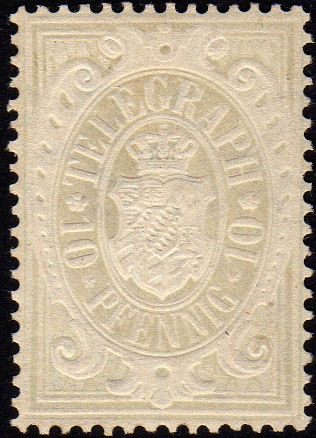 |
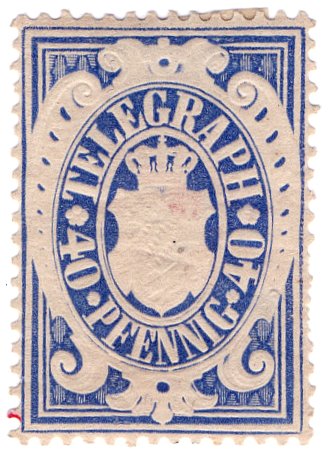 |
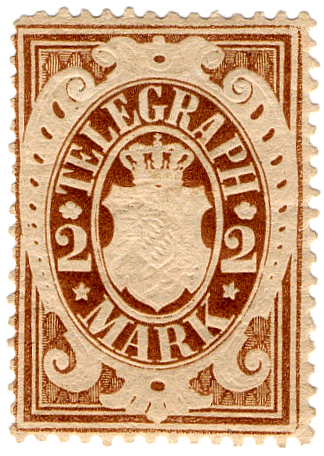 |
| H9 courtesy of Andrew Higson. | H12 courtesy of ibredguy.co.uk | H14 courtesy of ibredguy.co.uk |
Proofs also exist of a 5 Pfennig value that was not issued.
| Hisc. | Description | Mint | Used |
|---|---|---|---|
| H9 | 10Pfg pale bluish grey | 50.00 | 50.00 |
| H9a | without watermark | 100.00 | 100.00 |
| H10 | 20Pfg purple | 85.00 | 85.00 |
| H10a | without watermark | 170.00 | 170.00 |
| H11 | 25Pfg carmine | 120.00 | 120.00 |
| H11a | without watermark | 240.00 | 240.00 |
| H12 | 40Pfg blue | 85.00 | 85.00 |
| H12a | without watermark | 170.00 | 170.00 |
| H13 | 1M yellow | 120.00 | 120.00 |
| H13a | without watermark | 240.00 | 240.00 |
| H14 | 2M light brown | 110.00 | 110.00 |
| H14a | without watermark | 220.00 | 220.00 |
| H15 | 4M orange | 110.00 | 110.00 |
| H15a | without watermark | 220.00 | 220.00 |
Hiscocks added the following 3 notes:
| Note 1. There would seem to be some doubt whether Nos. 13 and 15 were in fact issued. |
| Note 2. The unwatermarked varieties derive from the printing of larger sheets (2 panes of 4 x 5) onto the old paper resulting in one (the bottom) row missing the watermark. Watermarked and unwatermarked varieties thus occur in the ratio 4:1. |
| Note 3. Gutter pairs again exist for all values — both watermarked and unwatermarked — and are again very rare. |
1876 (21 January ?) Same design, but on laid paper of watermark W2. Perf. 11
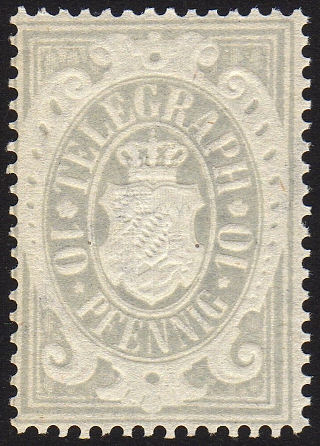 |
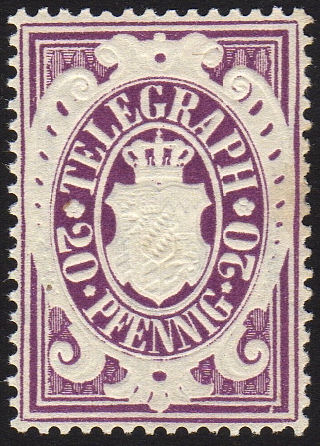 |
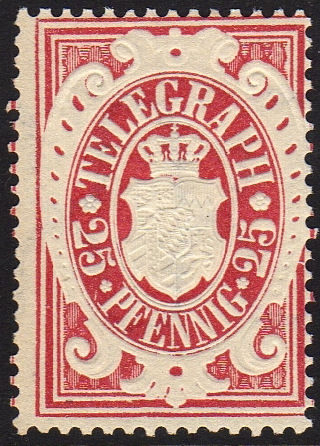 |
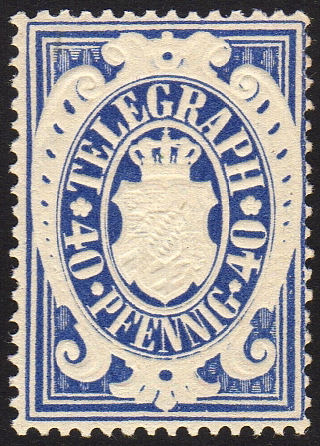 |
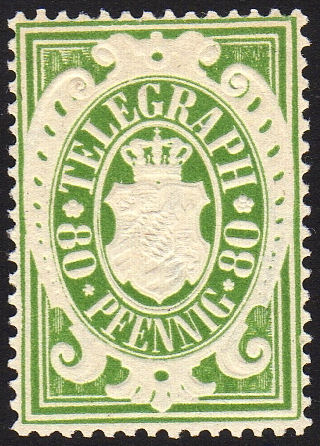 |
| H16 | H17 | H18 | H19 | H20 |
| Last 1876 series, courtesy of Andrew Higson. | ||||
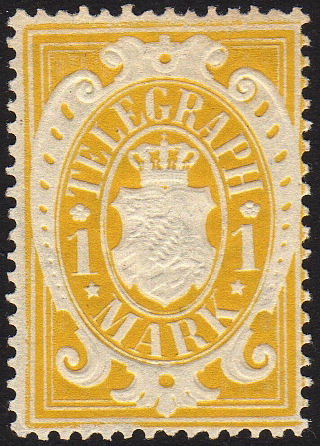 |
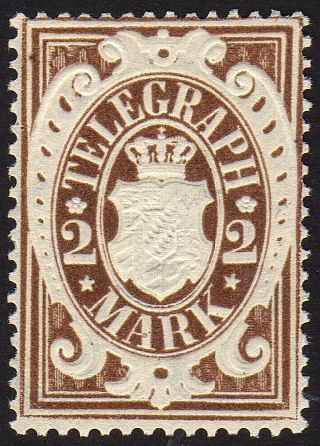 |
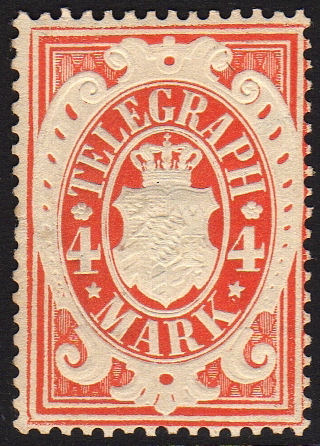 |
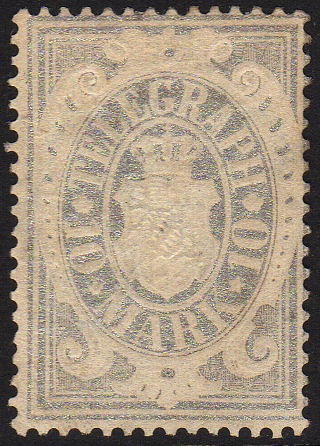 |
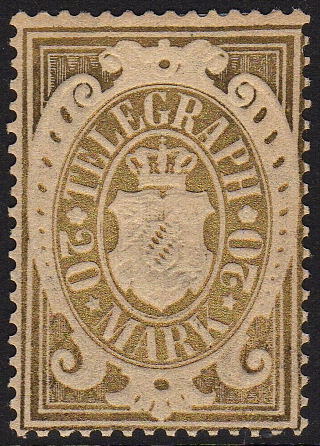 |
| H21 | H22 | H23 | H24 | H25 |
| Last 1876 series, courtesy of Andrew Higson. | ||||
Used examples are relatively scarce.
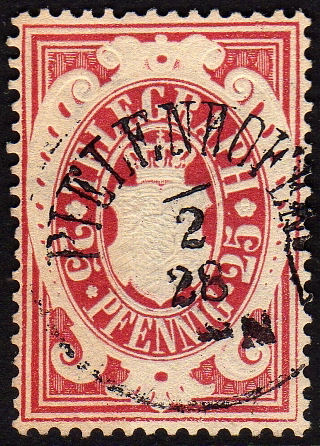 |
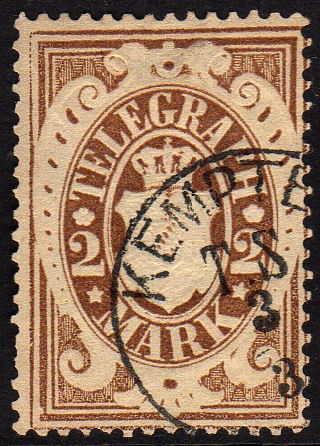 |
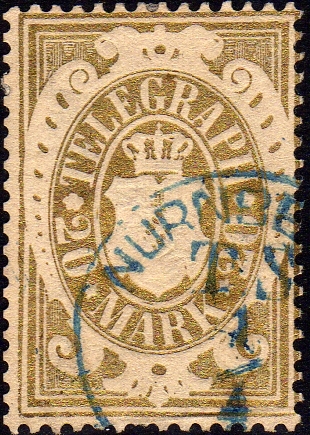 |
| H18 used | H22 used | H25 used (also illustrated by J. Barefoot) |
| Used examples of the last 1876 series, courtesy of Andrew Higson. | ||
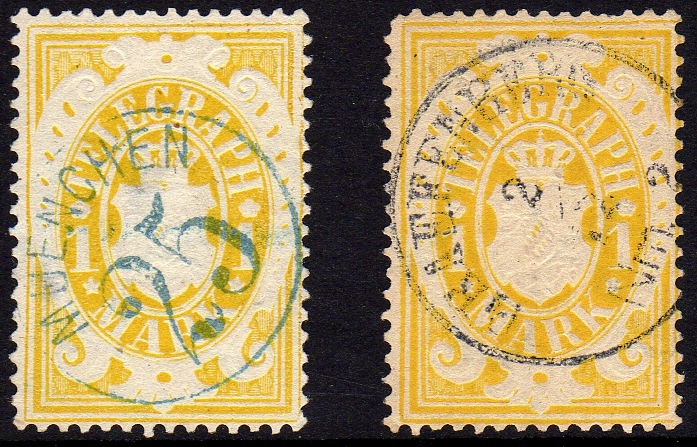
Two shades of the 1 Mark used, courtesy of Andrew Higson.
Hiscocks added the following 3 notes:
| Note 1. The very few used copies I have seen have been cancelled with handstamped numbers which could be part of the date. |
| Note 2. Imperforate reprints of No. 17 are known. They are on laid paper watermarked with parallel wavy lines (W3 of telephone stamps) and have "Nachdruck" on the reverse. [shown below] |
| Note 3. The use of telegraph stamps in Bavaria ceased on 31 December 1880. |
My Note: I do not know what Hiscocks meant by 'join in paper' (H18a and H20a)
As he noted for the earlier two series, there are also gutter pairs for the last series.
Gutter-pairs (Courtesy of Andrew Higson).
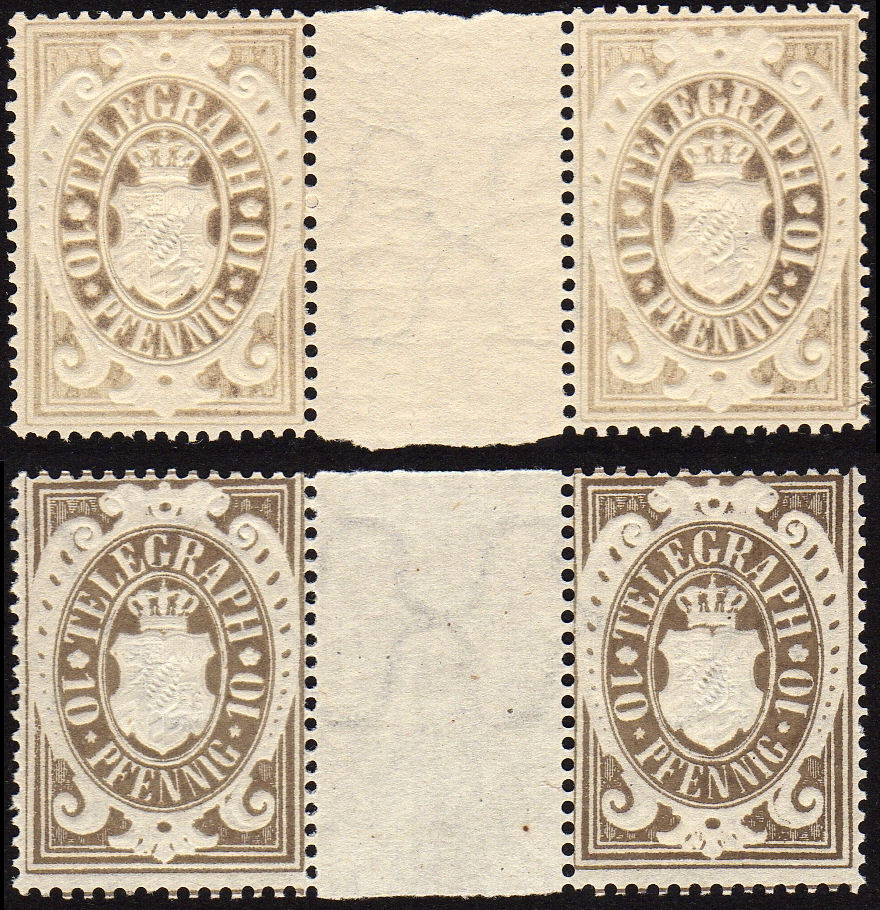
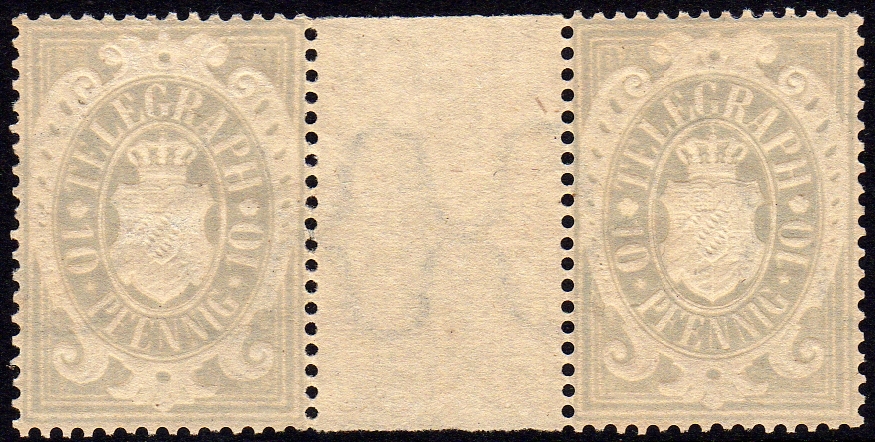
3 pairs showing very different shades of the 10pf. The top 2 were scanned together.
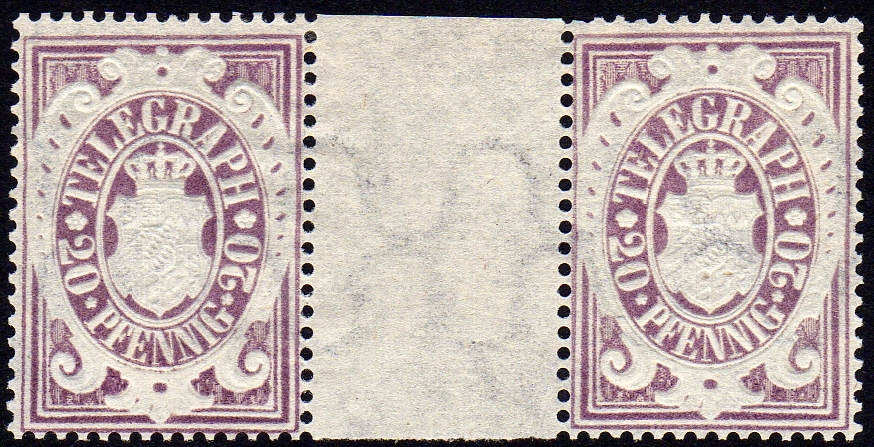
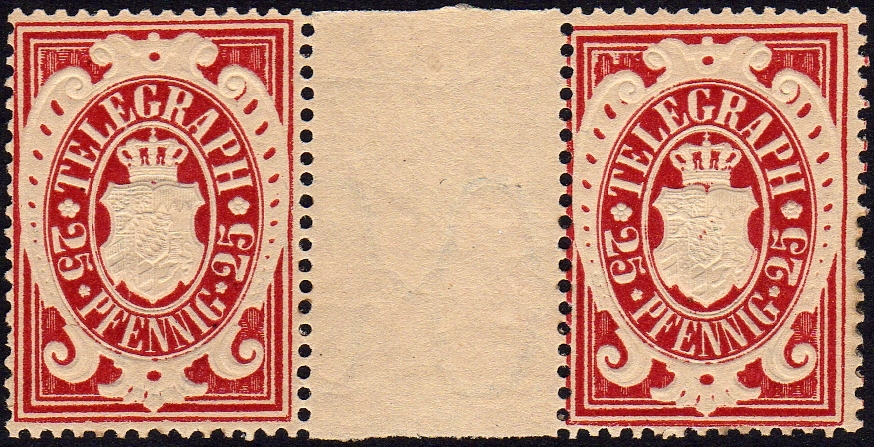
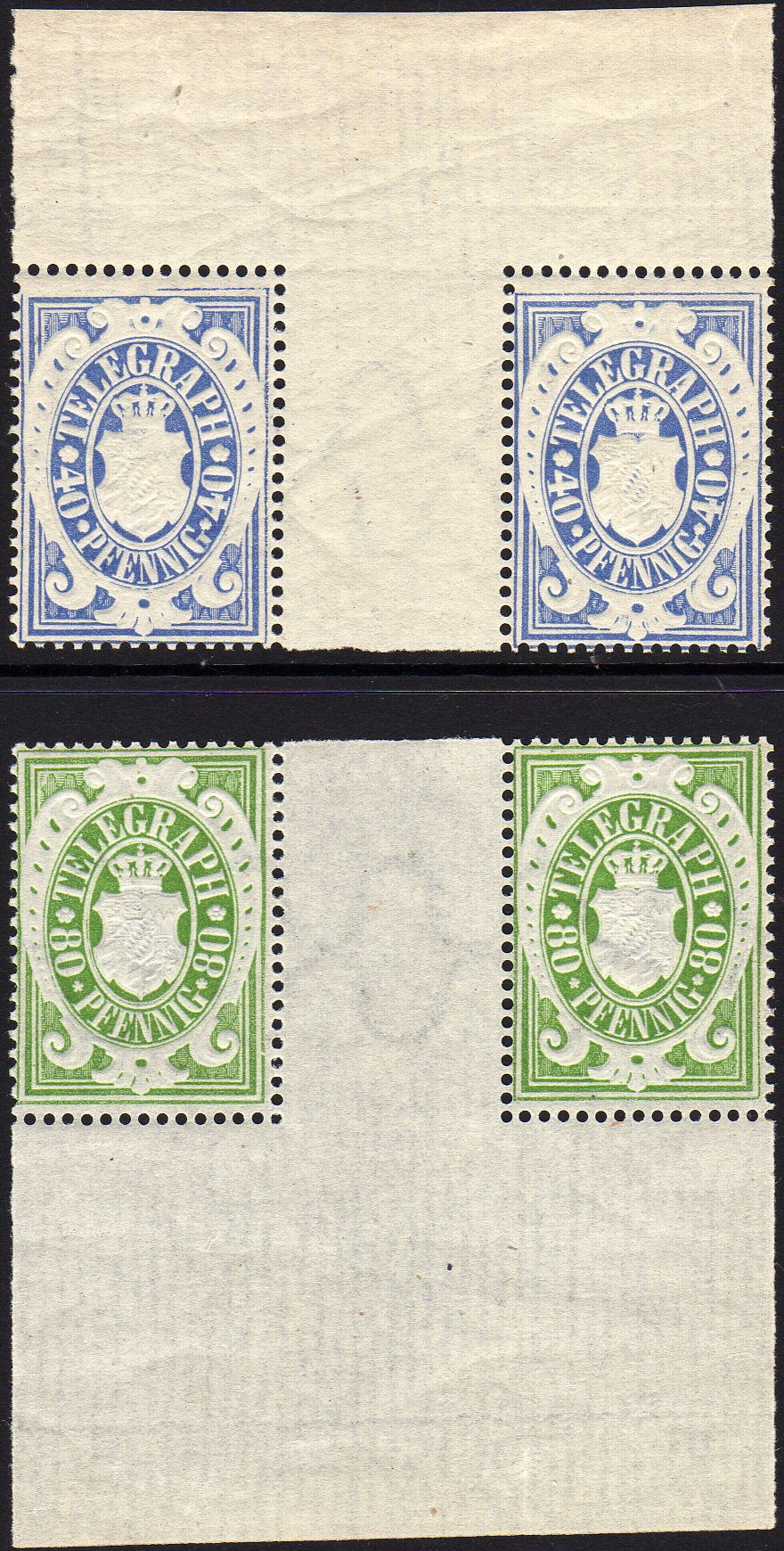
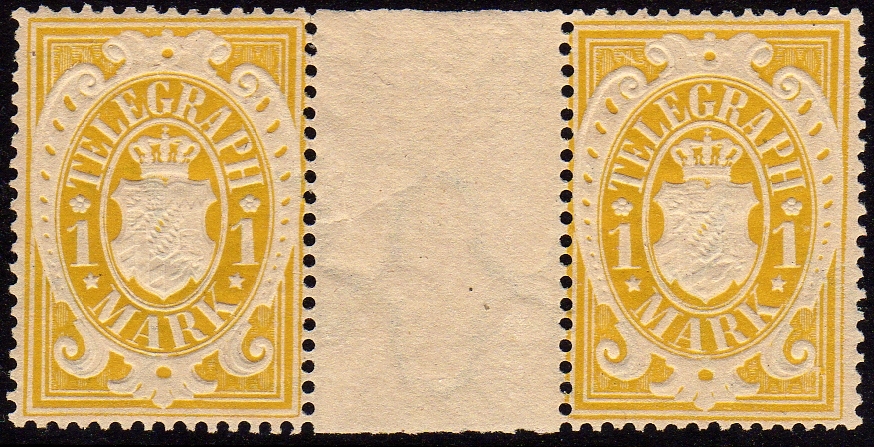
Gutter pairs exist because the sheets had two panes of 20 stamps like the pane below (note the perforations on the right-hand side):
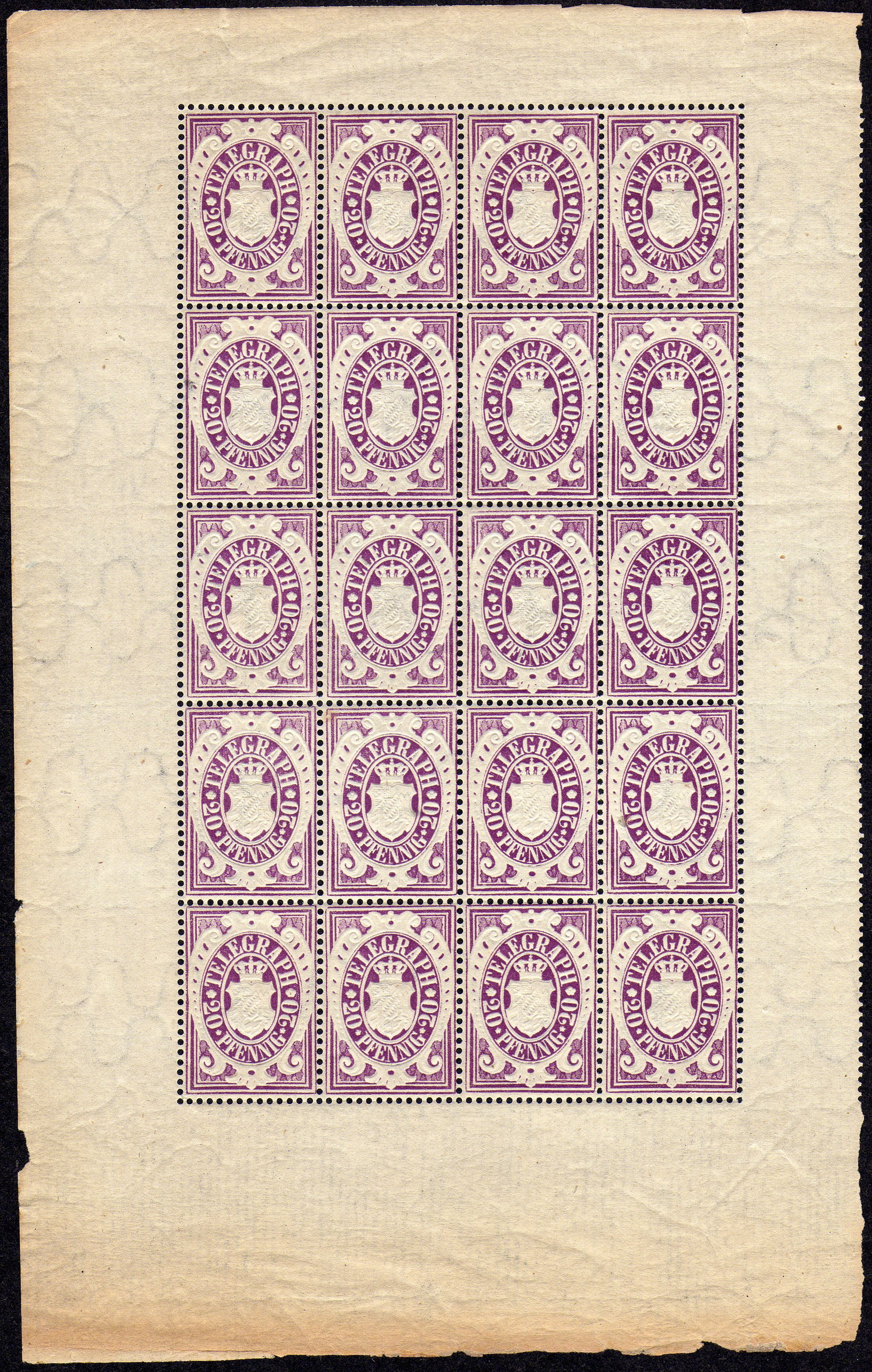
Image courtesy of Andrew Higson
Reprints (front and back, see Note 2 above).
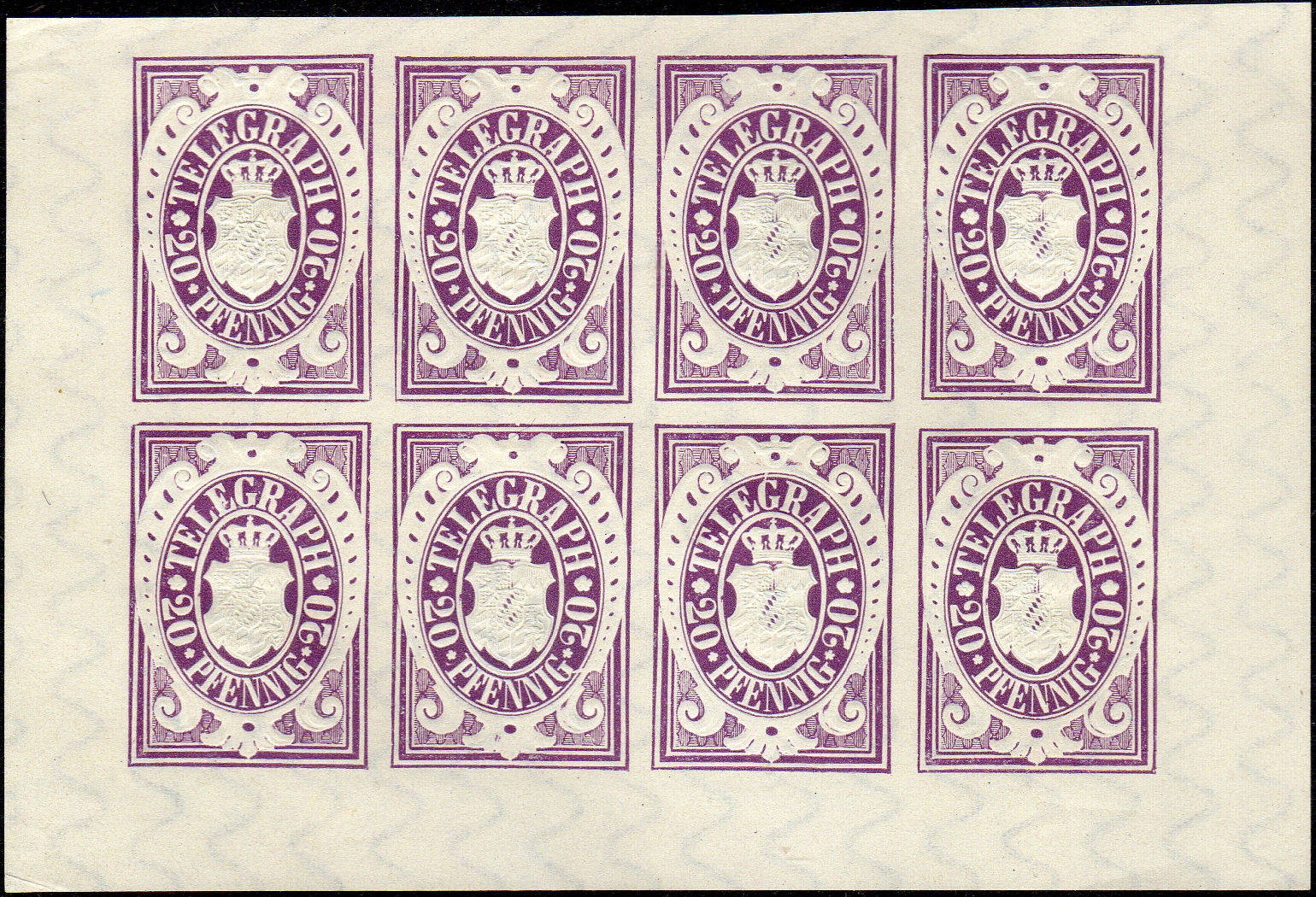
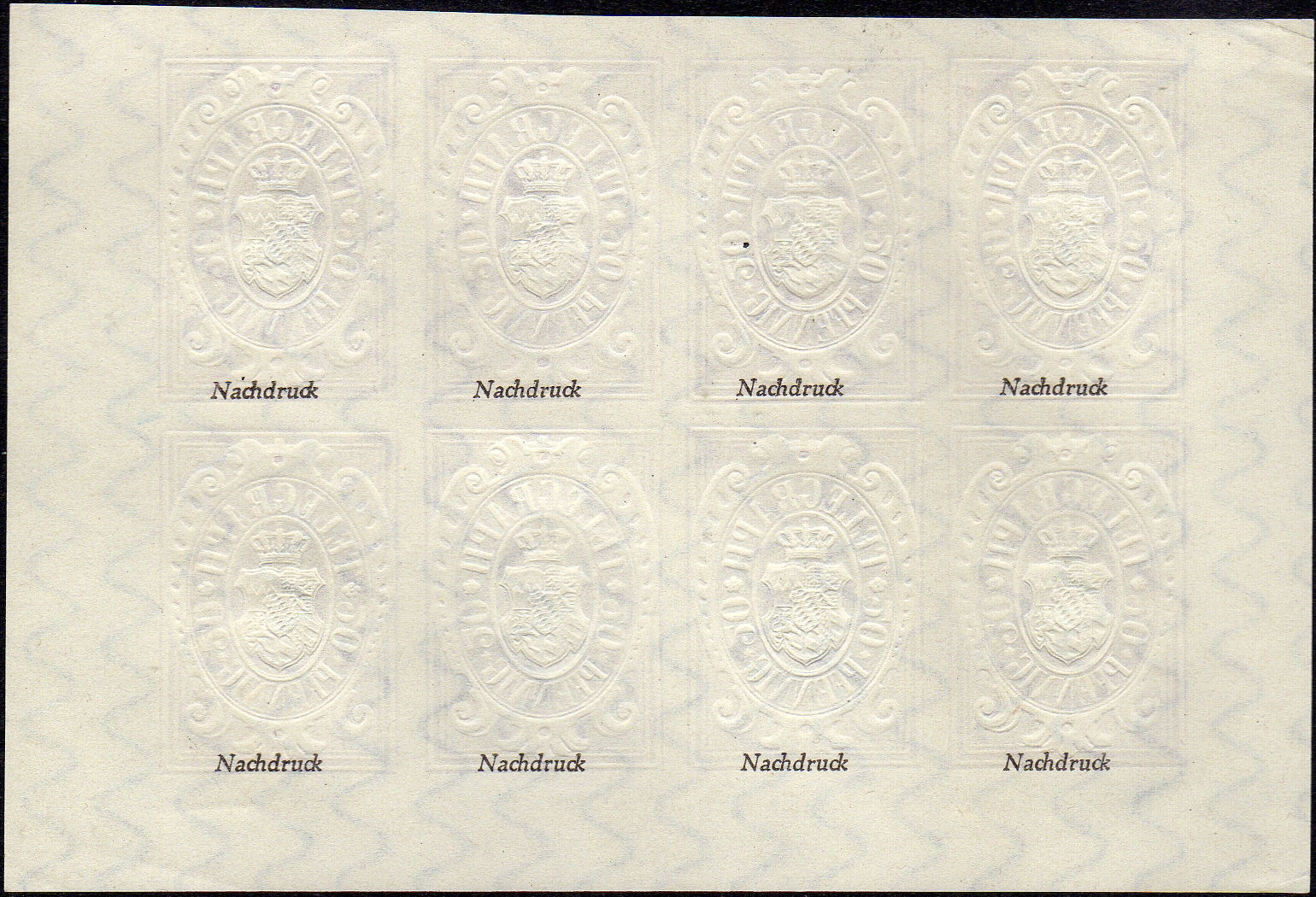
The Telephone stamp watermark (W3 below) can clearly be seen. Images courtesy of Andrew Higson.
II. Telephone Stamps.
A. Private Telephone Stamps.
1883 (5 November) Lithographed in black on coloured papers as indicated.
Town indicated at top. Control number in black or red. Perf. 12½.
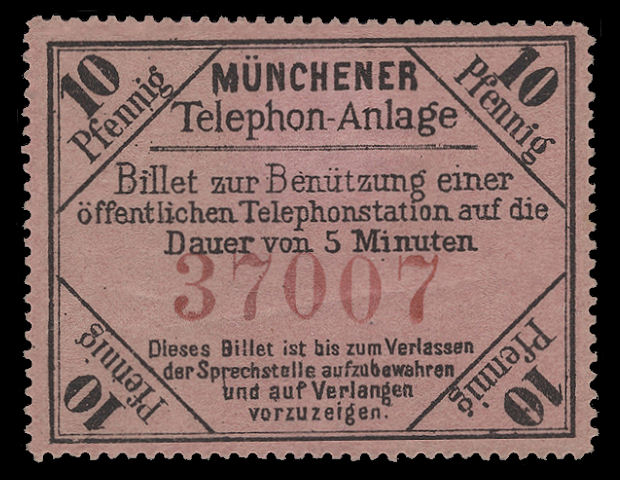
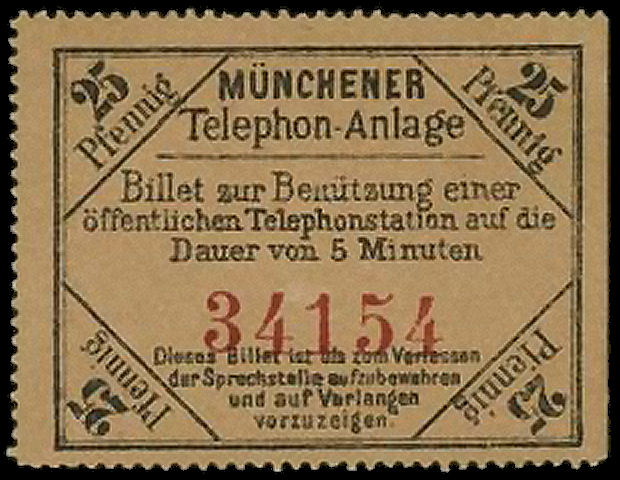

Type 1 taken from Wikimedia Commons.
11 Würzenburg
| Hisc. | Description | Mint | Used |
|---|---|---|---|
| H41 | 10Pfg black / rose (1.12.87) | 350.00 | 350.00 |
| H41a | control in red | 350.00 | 350.00 |
| H42 | 25Pfg black / brown (1.12.87) | 350.00 | 350.00 |
| H42a | control in red | 350.00 | 350.00 |
| H43 | 50Pfg black / pale brown (Date ?) | 350.00 | 350.00 |
| H44 | 1M black / violet (red control) (1.12.87) | 350.00 | 350.00 |
Hiscocks added the following 2 notes:
| Note 1. It is not absolutely clear from the source from which the above information was taken whether those values for which the date of issue (in brackets) is unknown do in fact exist. Pending further information I have assumed they do. |
| Note 2. All references I have found to these stamps describe them as rare but give no information on which a realistic price might be based. Those given above are largely guesswork. |
B. State Telephone Stamps.
1891 (1 January) Typographed on pink laid paper, watermarked W3. Imperf.
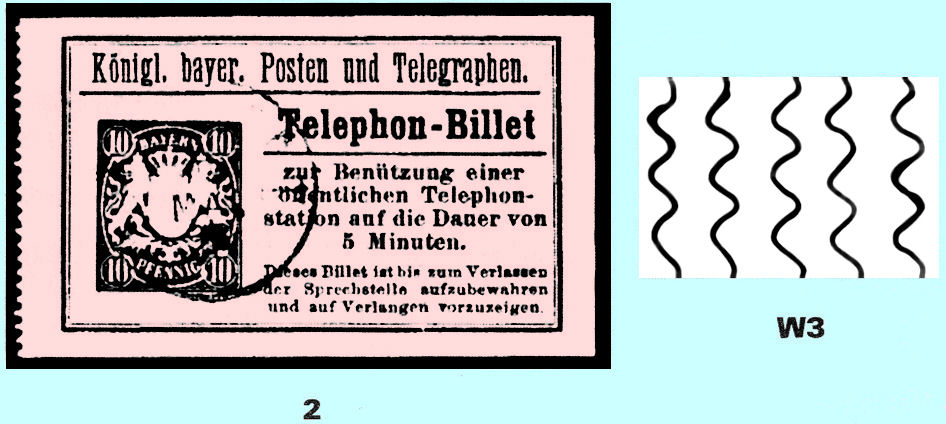
taken from pages 122 of Hiscocks book and coloured approximately.
| Hisc. | Description | Mint | Used |
|---|---|---|---|
| H45 | 10Pfg black / pink | 30.00 | 20.00 |
| H45a | perf. 11½ on left | 30.00 | 20.00 |
| H46 | 25Pfg black / pink | 60.00 | 40.00 |
| H43 | 50Pfg black / pink | 60.00 | 40.00 |
| H44 | 1M black / pink | 80.00 | 60.00 |
Hiscocks added the following note:
| Note. A 20Pfg value exists in the German Postal Museum. It was not apparently issued. |
1892 As above but on white paper. No watermark. Imperf.
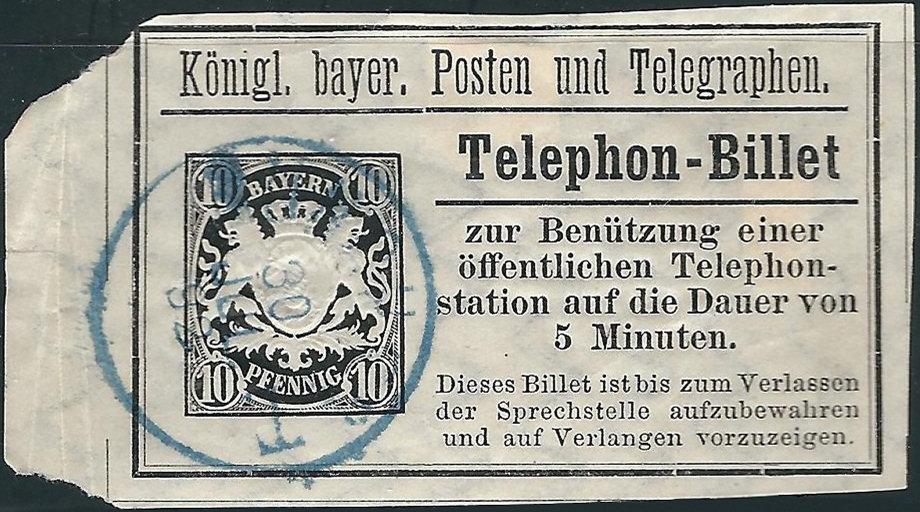
The example of H49 above is dated 30 July 1892. I have therefore amended the date of 1893 given by Hiscocks.
Image courtesy of Dick Keiser.
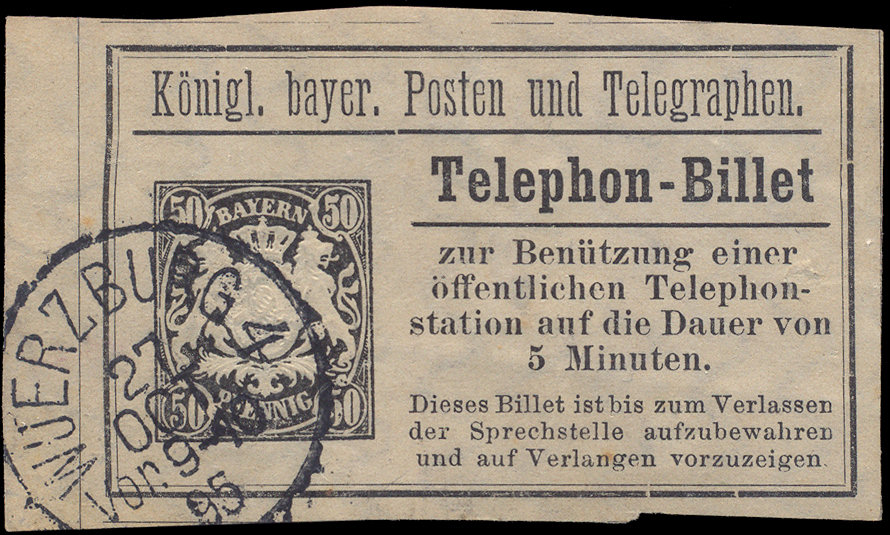
This example of H51 is dated 27 October 1895 which is some time after the perforated ones were available.
Image courtesy of Rolf Lamprecht.
| Hisc. | Description | Mint | Used |
|---|---|---|---|
| H49 | 10Pfg black | 30.00 | 30.00 |
| H50 | 25Pfg black | 60.00 | 30.00 |
| H51 | 50Pfg black | 60.00 | 60.00 |
| H52 | 1M black | 120.00 | 60.00 |
1894 Design as above but wording changed from "von 5 Minuten" to "von 3 bezw. 5 Minuten"
White paper. No watermark. Perf. 11½. Printed in sheets of 10 with 5 rows of 2.
Telegram Forms.
A telegram headed as German Austria used in Munich on 25 July 1866
The Austro-Prussian War of 1866 resulted in a win for Prussia and a loss for Austria, Bavaria, Saxony and Hanover.
The heading reflects that. There is a large image of the Bavarian Coat of Arms underneath.
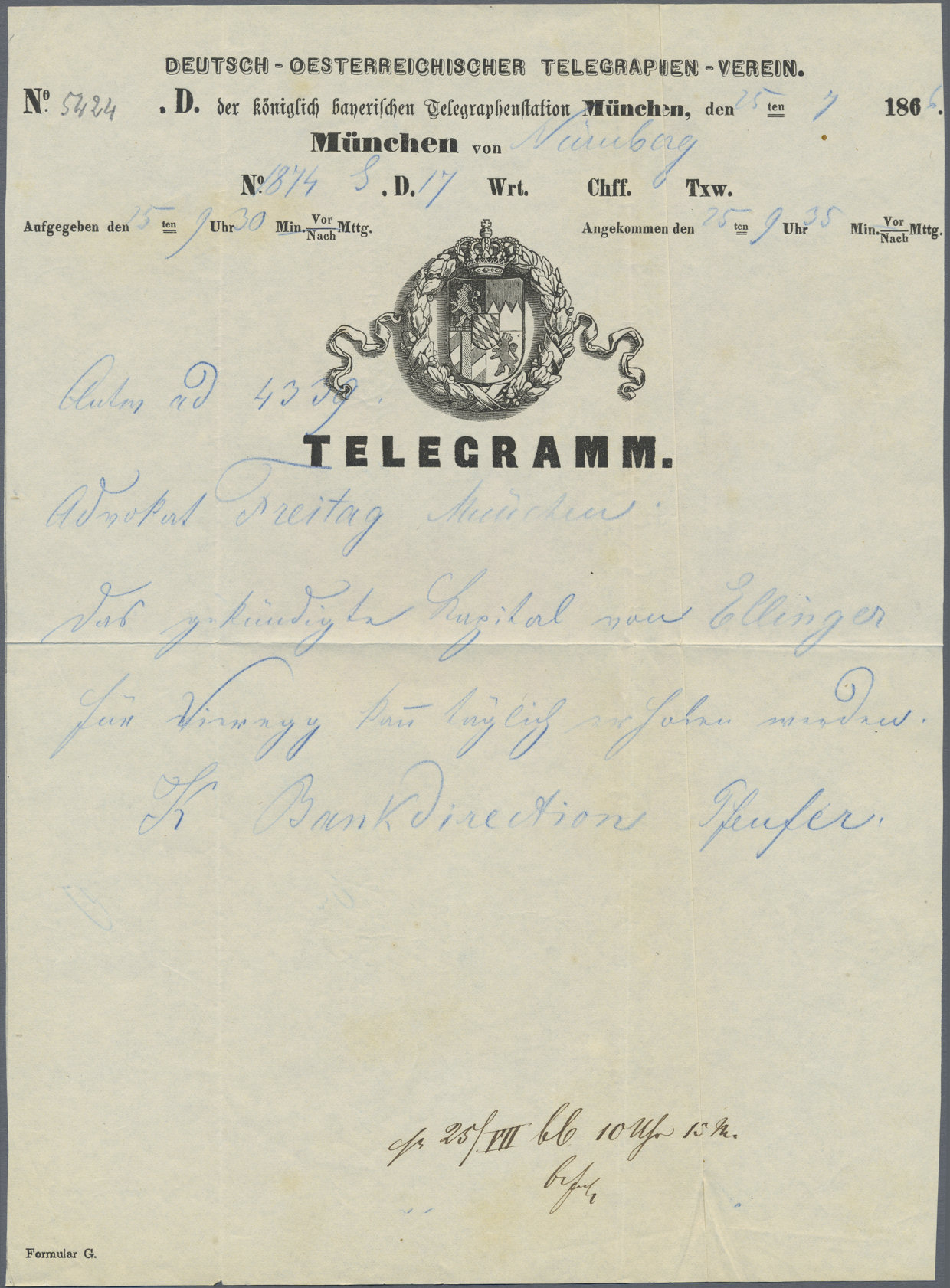
"Formular G." at bottom-left.
A telegram headed as German Austria used in 1871?
This is very similar to the last, but the year is pre-filled as "187" rather than "186".
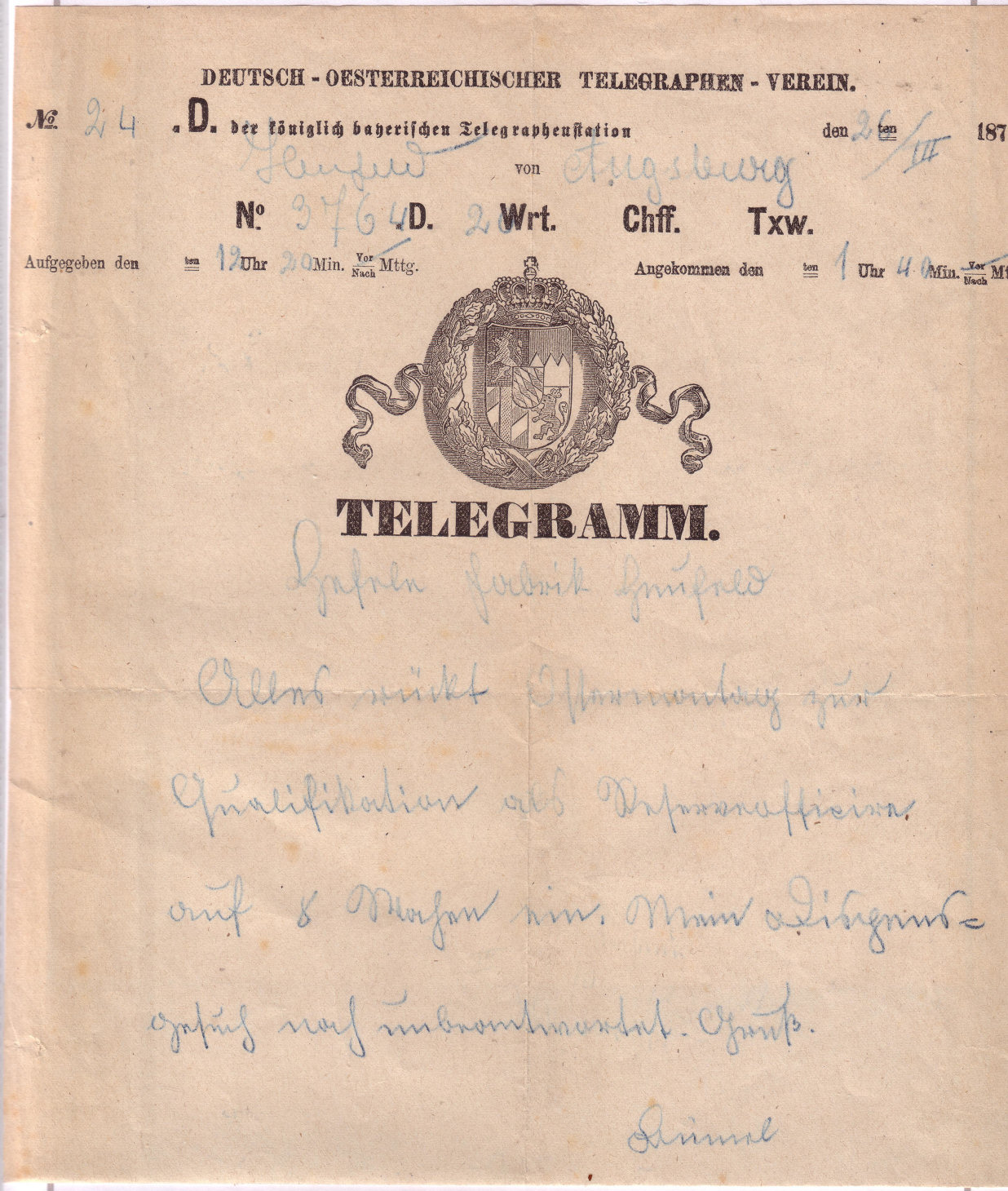
This appears to have been cut short. Image courtesy of Rolf Lamprecht.
A Bavarian telegram used in Brückenau in 1878
There is an image of the Bavarian Coat of Arms at the top.
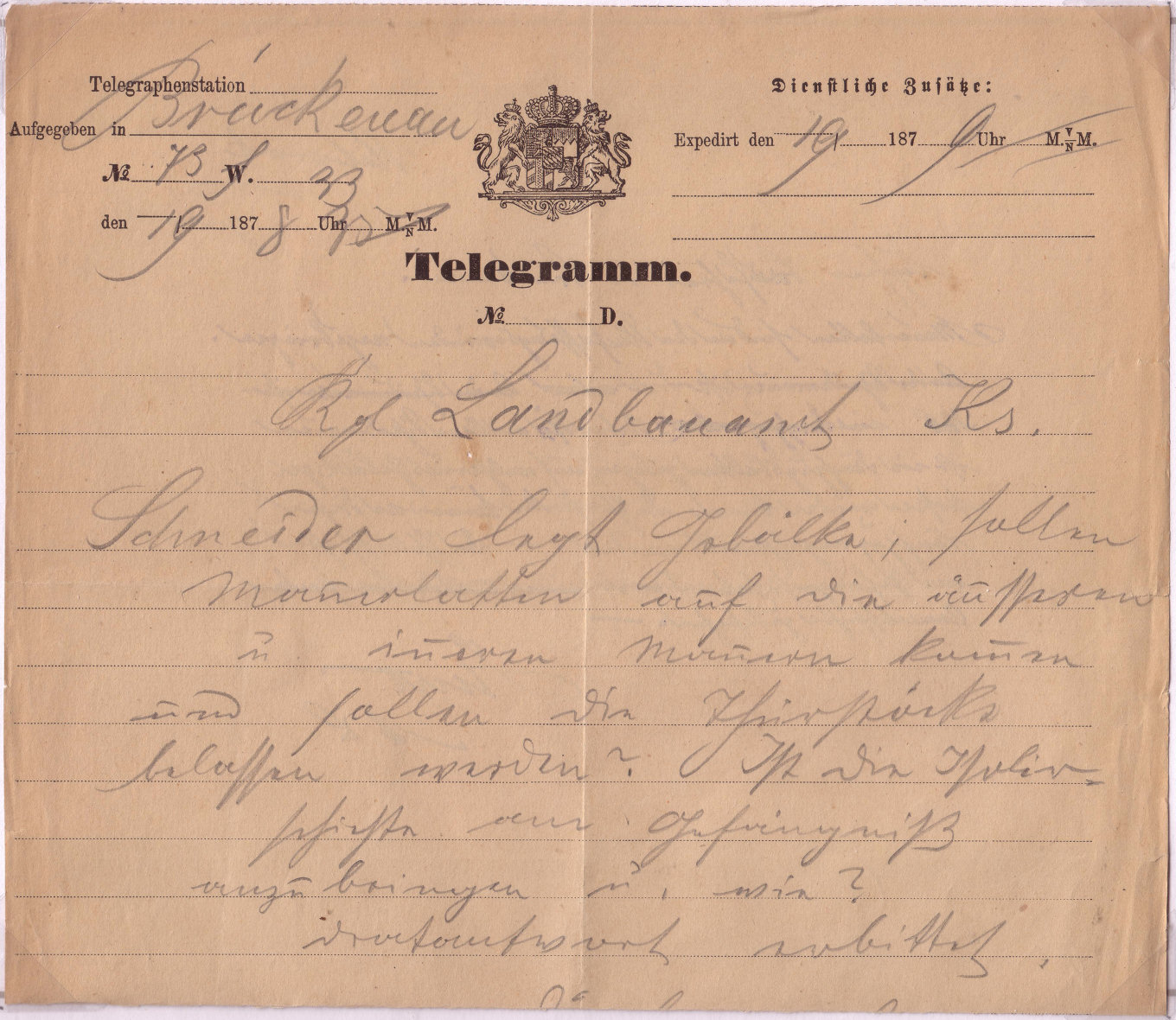
Image courtesy of Rolf Lamprecht.
2. North German Confederation.
Following the Austro-Prussian war (1866), a series of treaties, beginning in August 1866, between Prussia and
other North German States led to the creation of the North German Confederation in July 1867 with Berlin as its capital.
Initially Prussian postage stamps were used for telegraphic purposes.
Postage stamps of the North German Confederation became available on 1 January 1868.
I presume that they were then used for telegraphic purposes.
1869 (1 August) Typographed on white wove paper. No watermark, values overprinted in black. Perf. 13½ x 14½
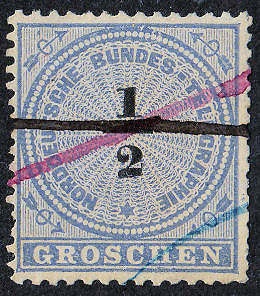 |
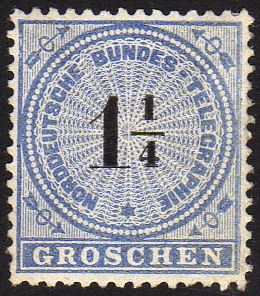 |
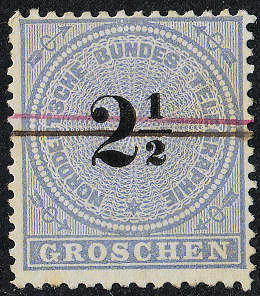 |
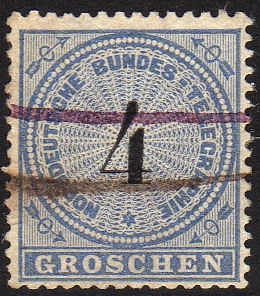 |
| H1 - ½ Groschen | H2 - courtesy of Andrew Higson. | H3 - 2½ Groschen | H4 - courtesy of Andrew Higson. |
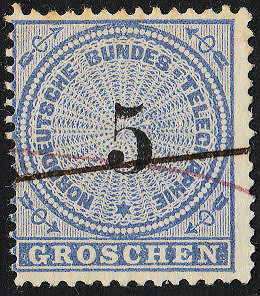 |
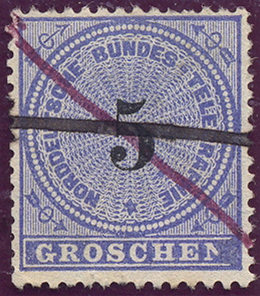 |
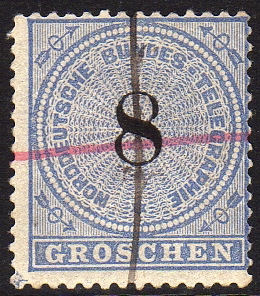 |
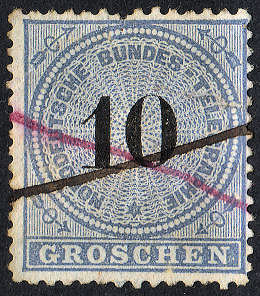 |
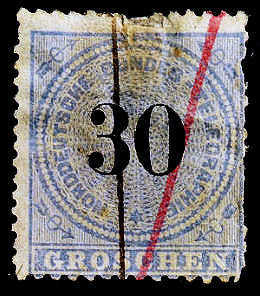 |
| H5 - 5 Groschen | RH5a - 5 Groschen - Broken "N" courtesy of Rolf Lamprecht |
H6 - courtesy of Andrew Higson. | H7 - 10 Groschen | H8 - courtesy of Mustafa Kocabasi. |
The "Broken N" variety may have been caused by something on the plate while printing. The end of the frame is also missing.
I would be interested in hearing of other examples like this.
Hiscocks added the following 2 notes:
| Note 1. Cancellations are usually penstrokes in red and in black — usually both colours on each used stamp. |
| Note 2. It is easy to confuse these stamps with those of the German Empire which are of very similar design and colours. The word 'GROSCHEN' is in white on Confederation stamps and in black on Empire stamps. |
These stamps were superseded by the Stamps of the German Empire when they became available at the end of October 1872. Apparently the Telegraphic stationery continued to be used for some time:
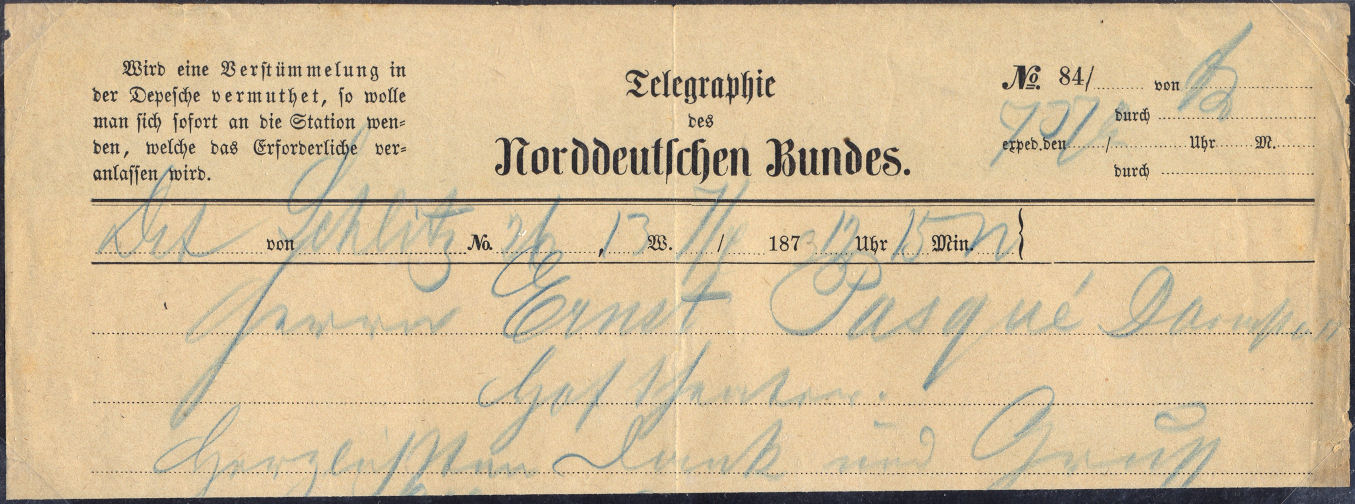
Part of a telegram of 1873. At the top-left, it says "Wird eine Berstümelung in der Depesche vermuthet, so wolle man
sich sofort an die Station wenden, welche das Erforderliche veranlassen wird."
which roughly translates as "If the despatch is suspected to have been tampered with, one should immediately turn to the station, which will do the necessary."
Image courtesy of Rolf Lamprecht.
3. Prussia.
1864 (15 June) Typographed on white or bluish wove paper. No watermark, rouletted.
These were used at the Berlin Stock Exchange.
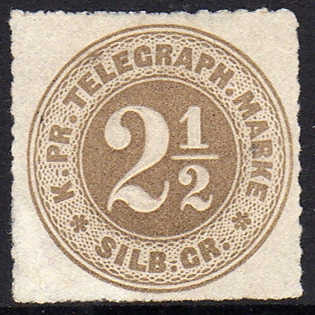 |
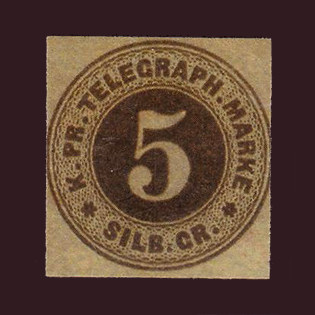 |
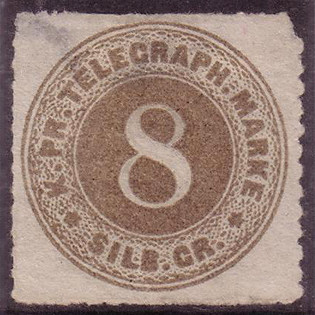 |
| H1 - courtesy of Andrew Higson. | H2 fake - courtesy of Rolf Lamprecht. | H3 - courtesy of Rolf Lamprecht. |
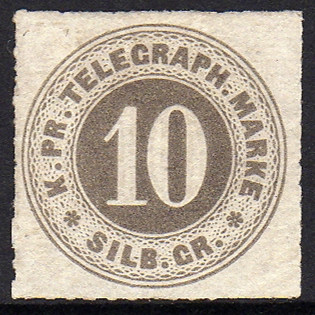 |
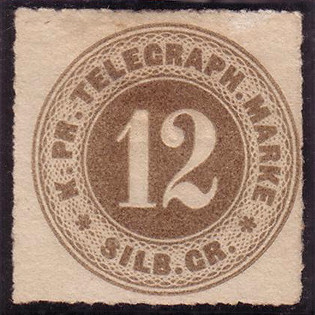 |
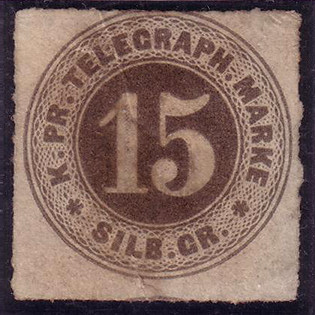 |
| H4 - courtesy of Andrew Higson. | H5 - courtesy of Rolf Lamprecht. | H6 - courtesy of Rolf Lamprecht. |
Did you notice the fake? This is to the same scale as the others. It was sold, along with the rest of the set, in a 'Buy it Now' on the internet.
There is a growing cottage industry churning out 'facsimiles', 'reprints' and 'reproductions' for sale on the internet. Some are passed off as genuine.
John Barefoot warns with these "Beware of modern litho or photocopy reproductions". Good advice, but how do you tell from an image (often strangely blurry) on the internet ?
Blurriness can certainly be a clue about having something to hide, but check perforations (these should show rouletting),
paper (modern productions are usually on modern, very white paper), as well as history of the seller. The genuine are about 22.5mm diameter, the fake is 19.5mm diameter.
Rolf has a set of these at that size, all bought together. He thinks they may be trials, but I do not think so. There are also small versions of Jammu & Kashmir stamps being sold on eBay.
The 15Sgr, H6 here shows part of the stamp below, this gives an idea of the spacing.
| Hisc. | Description | Mint | Used |
|---|---|---|---|
| H1 | 2½Sgr brownish to greyish black (1.10.67) | 500.00 | 700.00 |
| H1a | bluish paper (1868?) | 500.00 | 700.00 |
| H2 | 5Sgr brownish to greyish black (1.10.67) | 1200.00 | 1650.00 |
| H2a | bluish paper (1868?) | 1200.00 | 1650.00 |
| H3 | 8Sgr brownish to greyish black | 550.00 | 750.00 |
| H3a | bluish paper (1868?) | 550.00 | 750.00 |
| H4 | 10Sgr brownish to greyish black | 550.00 | 750.00 |
| H4a | bluish paper (1868?) | 550.00 | 750.00 |
| H5 | 12Sgr brownish to greyish black | 550.00 | 750.00 |
| H5a | bluish paper (1868?) | 550.00 | 750.00 |
| H6 | 15Sgr brownish to greyish black | 1100.00 | 1200.00 |
| H6a | bluish paper (1868?) | 1100.00 | 1200.00 |
Hiscocks added the following 2 notes:
| Note 1. Use of these stamps ceased on 31 July 1869. |
| Note 2. Cancellation was by a 'T' shaped punch. |
My note: According to Yvert et Tellier, Prussian stamps were replaced by those of the North German Confederation on 1/1/1868.
However, they were not available until 1st August 1869.
According to John Barefoot, Prussian postage stamps were used for telegraphic purposes at the Berlin Stock Exchange and Head Post Office from 1864 until then.
An interesting telegram headed as German Austria ? Used in Stettin (Szczecin) in 1867.
The Austro-Prussian War of 1866 resulted in a win for Prussia (then in control of Stettin) and a loss for Austria, Bavaria, Saxony and Hanover.
The heading reflects that.
As a result of the war, according to Britanica.com - 'the war was formally concluded on August 23 by the Treaty of Prague.
The treaty assigned Schleswig-Holstein to Prussia. The latter also annexed Hanover, Hesse-Kassel, Nassau, and Frankfurt outright,
thus acquiring the territory that had separated the eastern and the western parts of the Prussian state.
By the Peace of Vienna (October 3, 1866) Austria ceded Venetia for transfer to Italy. Prussia’s victory in the war enabled it to organize the North German Confederation.'
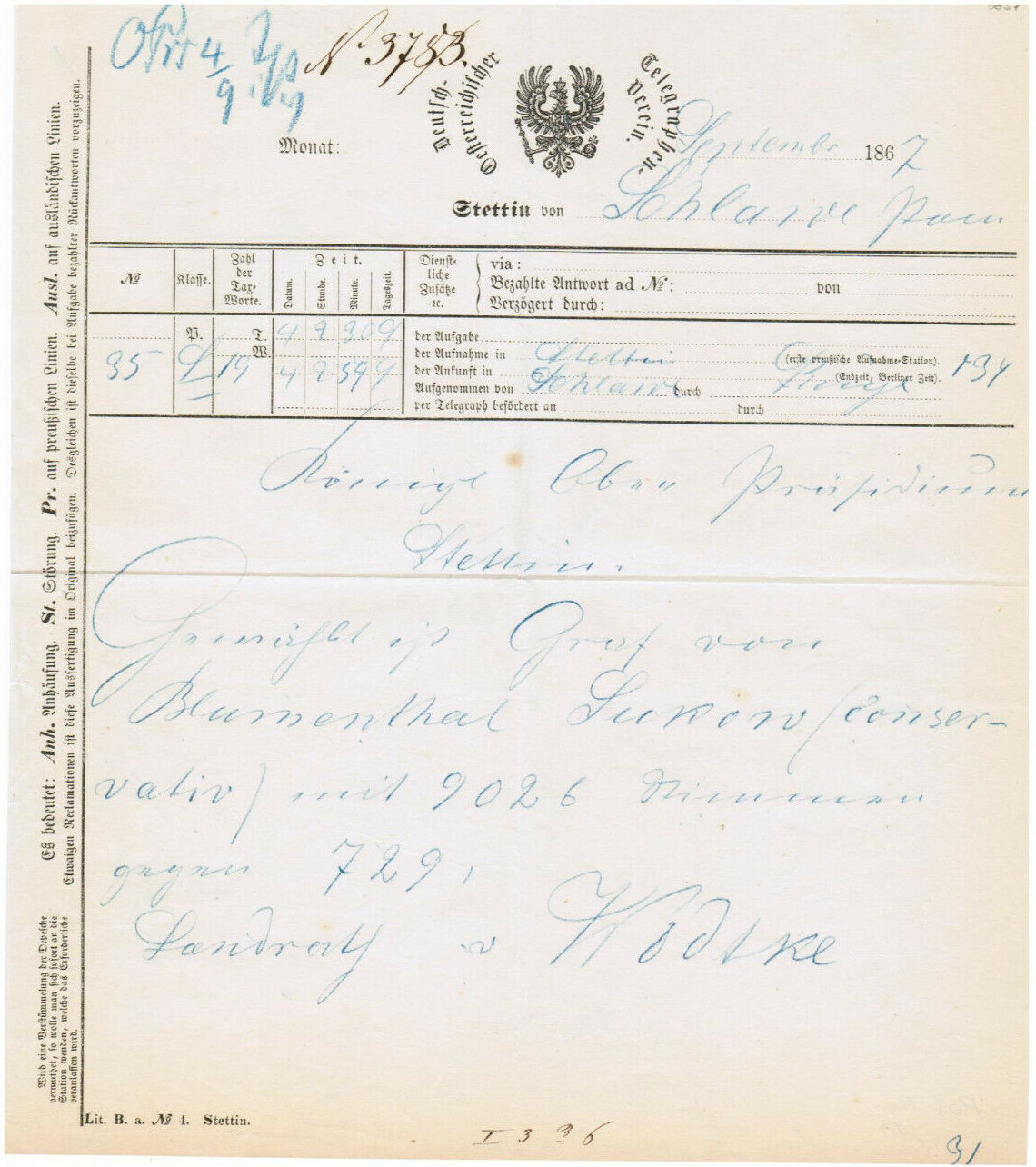
The bottom has an imprint showing the form was printed in Stetin. This image is from eBay item 164260424475 of September 2020 which is now deleted.
If you are the seller (or buyer) please contact me.
4. Württenberg.
I have revised Hiscocks' original listing due separating the stamp sizes. The new designations have 'RH' numbers (Revised Hiscocks) to avoid confusion. I have though left references to the original designations. |
1875 (1 January) to 1878 Typographed on white wove paper. No watermark, value overprinted at centre and bottom in black or blue. Rouletted, overall size 21 x 23½mm.
1878 new colours (80pf and 10M), overall size 21 x 23½mm.
1880 larger overall size 22 x 24½mm. These are very rare genuinely used.
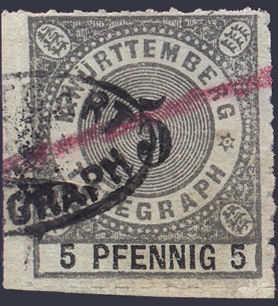 |
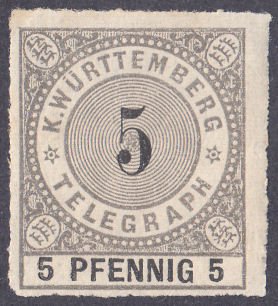 |
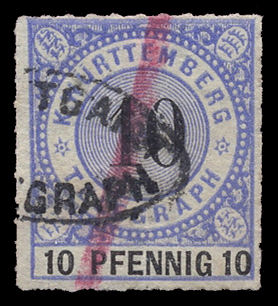 |
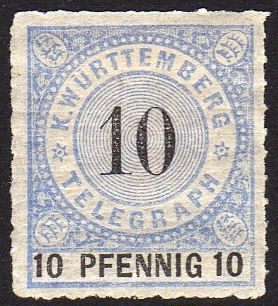 |
| 5 pf — RH1, Courtesy of Rolf Lamprecht. |
5 pf — RH1a | 10 pf — RH2, Courtesy of Rolf Lamprecht. |
10 pf — RH2a, Courtesy of Andrew Higson. |
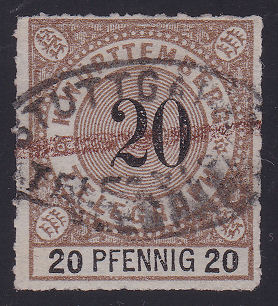 |
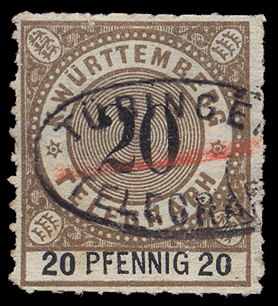 |
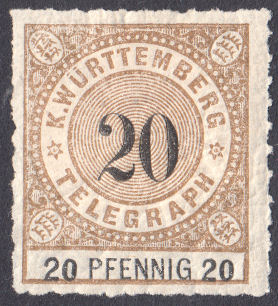 |
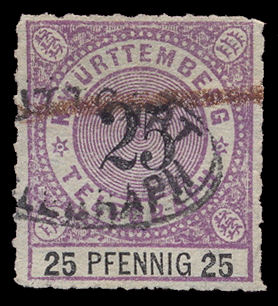 |
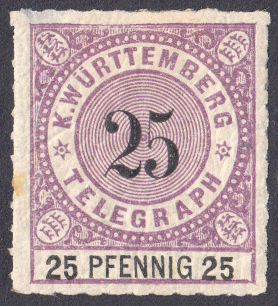 |
| 20 pf — RH3 ? | 20 pf — RH3a, Courtesy of Rolf Lamprecht. |
20 pf — RH3b | 25 pf — RH4, Courtesy of Rolf Lamprecht. |
25 pf — RH4a |
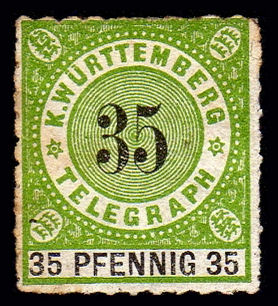 |
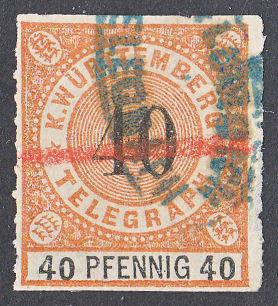 |
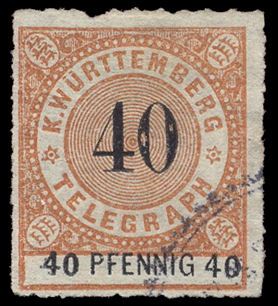 |
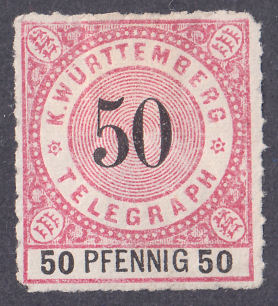 |
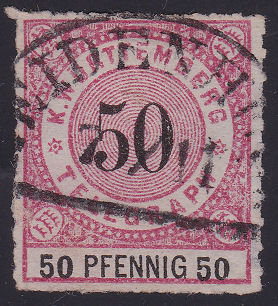 |
| Unissued 35 pf — RH5, Courtesy of Andrew Higson. |
40 pf — RH6 | 40 pf — RH6a, fake cancel?, Courtesy of Rolf Lamprecht. |
50 pfennig — RH7 | 50 pfennig — RH7, with railway cancel. |
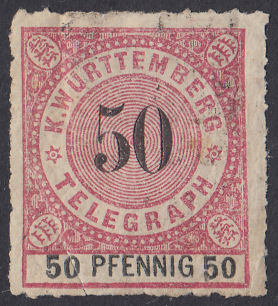 |
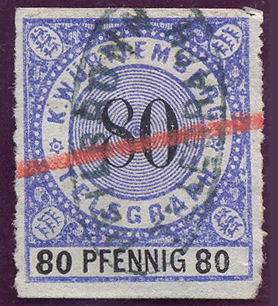 |
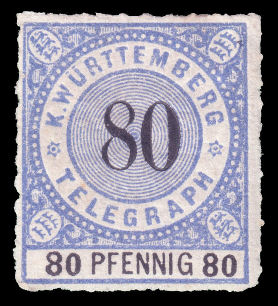 |
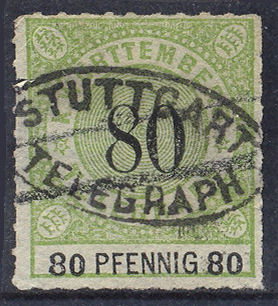 |
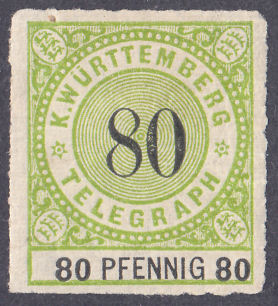 |
| 50 pfennig — RH7a | 80 pf — RH8, Courtesy of Rolf Lamprecht. |
80 pfennig — RH8, Courtesy of Peter Grözinger. |
80 pf — RH8a, Courtesy of Rolf Lamprecht. |
80 pfennig — RH8b |
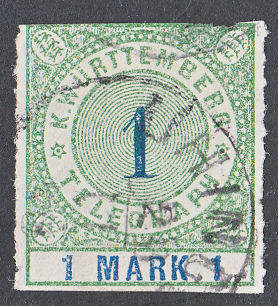 |
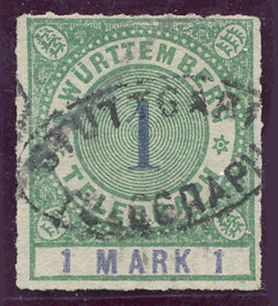 |
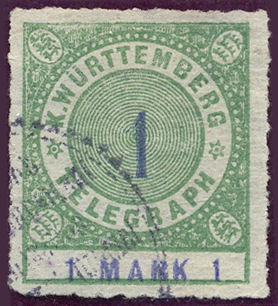 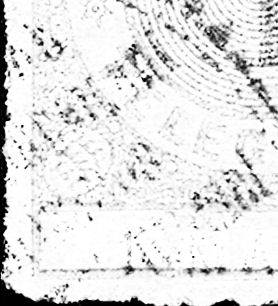 |
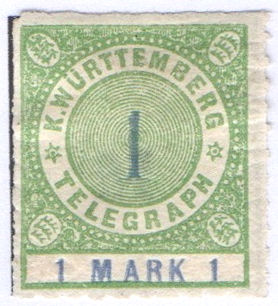 |
| 1 Mk — H9, with postal cancel. | 1 Mk — H9, with railway cancel, Courtesy of Rolf Lamprecht. |
1 Mk — H9, with a rather strange cancel, the same as a 40pf above. Does anyone recognise it? Image courtesy of Rolf Lamprecht. |
1 Mk — H9b, Courtesy of Les Bottomley. |
There are noticeable differences in the style and colour of the values on the 1 Mark stamps above. Note also the variable spacing between 'M A'.
Anyone know more about this ?
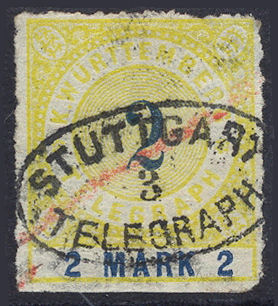 |
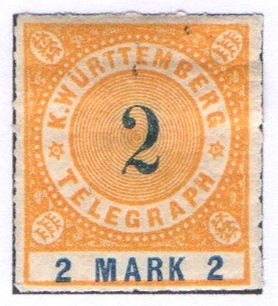 |
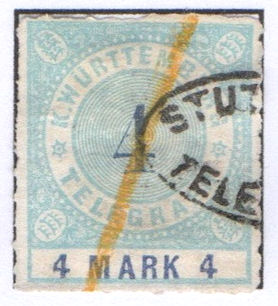 |
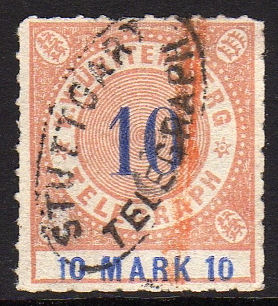 |
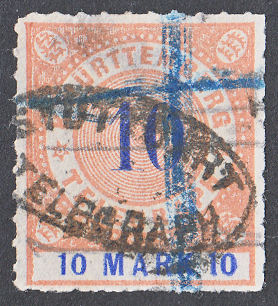 |
| 2 Mk — RH10, Courtesy of Rolf Lamprecht. |
2 Mk — RH10a, Courtesy of Les Bottomley. |
4 Mk — RH11, Courtesy of Les Bottomley. |
10 Mk — RH12a, Courtesy of Andrew Higson. |
10 Mk — RH12a |
Hiscocks refers to RH12 as being vermilion, whereas John Barefoot refers to it as orange. I have only seen examples of RH12a I think.
The German Michel catalogue describes the colours as Dunkelzinnoberrot / dunkelpreußischblau (Dark vermilion / dark Prussian blue) for RH12
and hellrötlichorange / dunkelultramarin (light reddish orange / dark ultramarine) for RH12a.
*John Barefoot refers to a last issue of 1880 as seeing little use and being slightly larger .
He quotes the earlier ones as 21 x 23½mm
and the later ones as 22 x 24½mm. Be aware that this is the overall dimensions of the stamps across the rouletting.
The dimensions of the design appear to be all about 19.3 x 22.3mm. I have incorporated these into the table below.
Hiscocks added the following 3 notes:
| Note 1. Cancellation was with handstamps, often with an additional crayon or pen stroke. The most common handstamps consist of ovals about 2cm long containing the town, e.g. Stuttgart, above and the word 'TELEGRAPH' below. |
| Note 2. The 35 Pfg value (No. 5) was not in fact issued and the 'used' copies reported from time to time are fraudulent. |
| Note 3. I have seen No. 9(a) described as missing the '1' from the bottom right corner. It is not clear whether this was mistaken or whether both varieties exist. I have assumed the former. |
After these were discontinued, normal postage stamps were used:
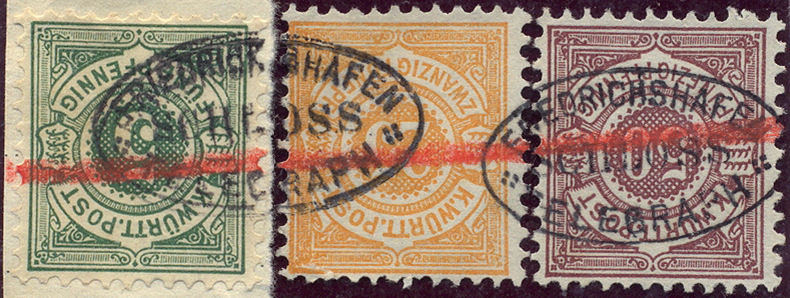
Image courtesy of Rolf Lamprecht.
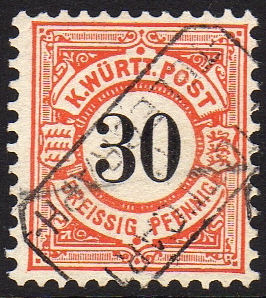 |
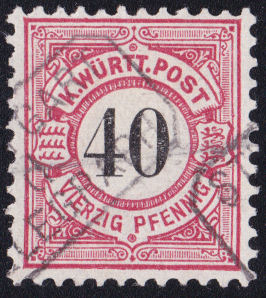 |
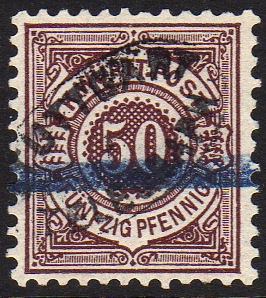 |
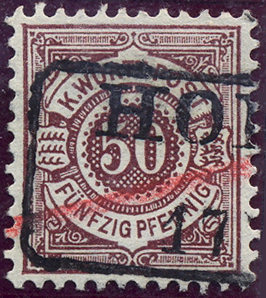 |
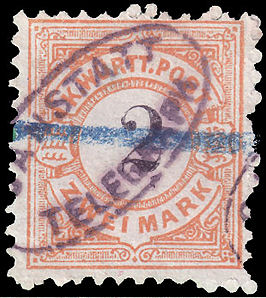 |
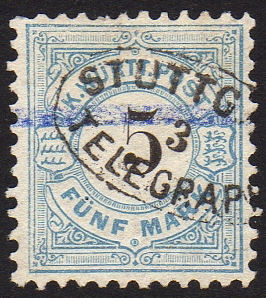 |
| 30pf — Courtesy of Andrew Higson. | 40pf | 50pf — Courtesy of Andrew Higson. | 50pf — Courtesy of Rolf Lamprecht. | 2 Mk — Courtesy of Peter Grözinger. | 5 Mk — Courtesy of Andrew Higson. |
The German Michel catalogue refers to the crayon marks on telegraphically used 30pf, 40pf, 2Mk and 5Mk above (MiNr. 61, 62, 53, 54) as
"telegraphische Entwertung" (telegraphic devaluation) and warns "Vorsicht vor nachträglicher Entfernung dieser Striche!" (Beware subsequent removal of these lines!).
5. German Empire.
1872 Typographed on white wove paper. No watermark, value and currency overprinted in black. Perf. 13½ x 14½
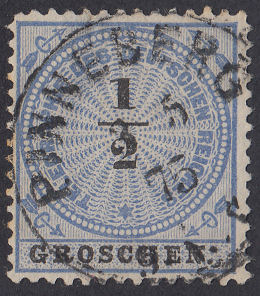 |
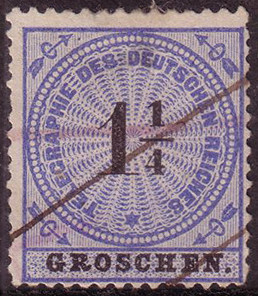 |
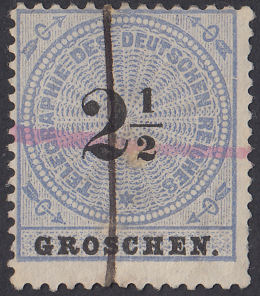 |
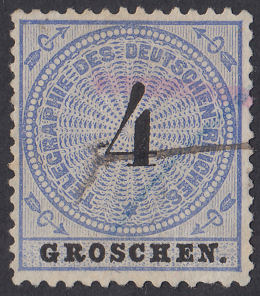 |
| H1 - ½ Groschen | H2 - 1¼ Groschen Courtesy of Rolf Lamprecht. |
H3 - 2½ Groschen | H4 - 4 Groschen |
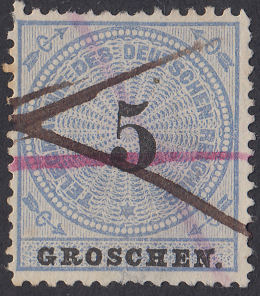 |
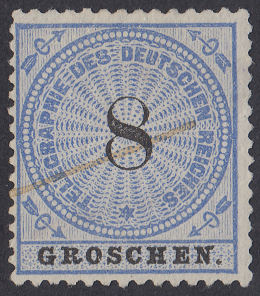 |
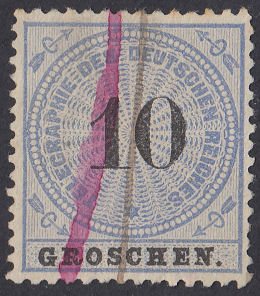 |
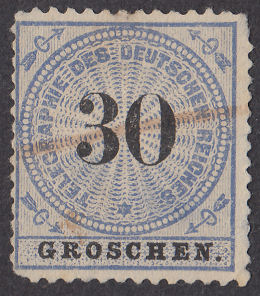 |
| H5 - 5 Groschen | H6 - 8 Groschen | H7 - 10 Groschen | H8 - 30 Groschen |
As can be seen, these are usually pen-cancelled, however small towns used postal cancels, generally dated 1875.
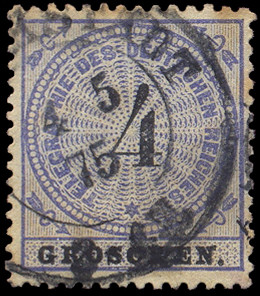
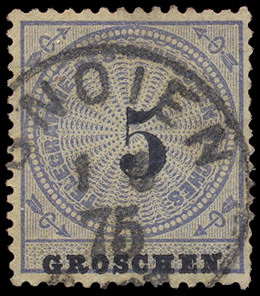
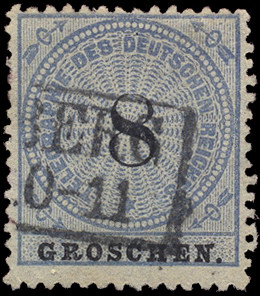
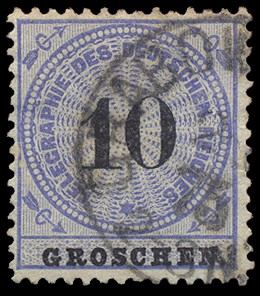
Steve Hiscocks said that these stamps were also used postally, but according to the Michel catalogue, these (and the following) stamps are not known on cover.
They are worth 3 or 4 times the pen-cancelled prices. Examples courtesy of Rolf Lamprecht.
| Hisc. | Description | Mint | Used |
|---|---|---|---|
| H1 | ½Gr blue (shades) and black | 16.00 | 4.00 |
| H2 | 1¼Gr blue (shades) and black | 30.00 | 10.00 |
| H3 | 2½Gr blue (shades) and black | 12.00 | 2.00 |
| H4 | 4Gr blue (shades) and black | 12.00 | 4.00 |
| H5 | 5Gr blue (shades) and black | 10.00 | 1.50 |
| H6 | 8Gr blue (shades) and black | 16.00 | 8.00 |
| H7 | 10Gr blue (shades) and black | 12.00 | 1.50 |
| H8 | 30Gr blue (shades) and black | 30.00 | 12.00 |
See also the notes below.
1875 As above but currency altered to Pfennige and Marks. Value and overprints in red on Mark values.
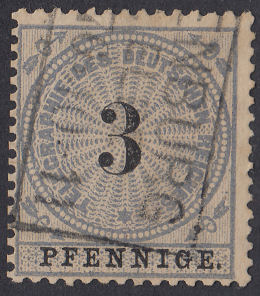 |
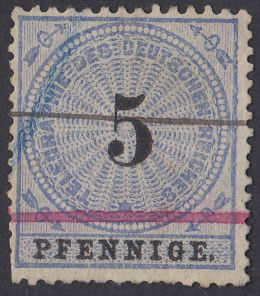 |
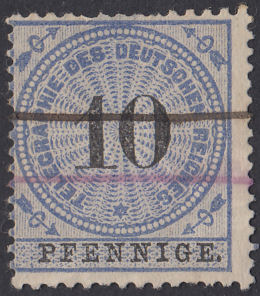 |
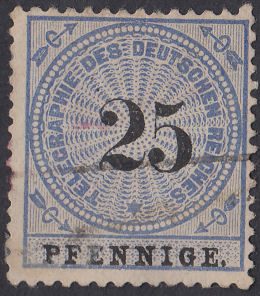 |
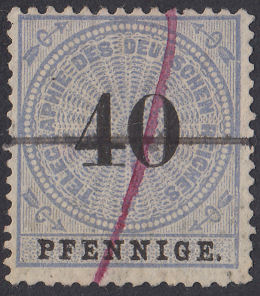 |
| H9 - 3 Pfennige | H10 - 5 Pfennige | H11 - 10 Pfennige | H12 - 25 Pfennige | H13 - 40 Pfennige |
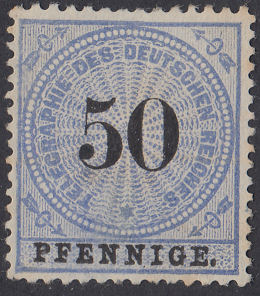 |
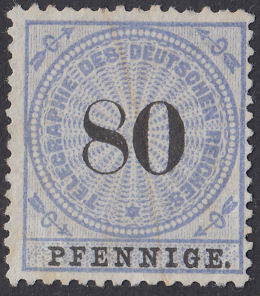 |
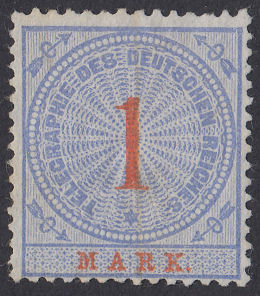 |
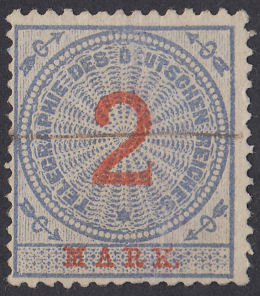 |
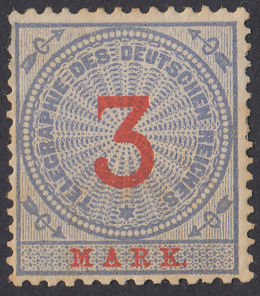 |
| H14 - 50 Pfennige | H15 - 80 Pfennige | H16 - 1 Mark | H17 - 2 Mark | H18 - 3 Mark |
As with the 1872 issue, small towns used postal cancels. Again these are generally dated 1875.
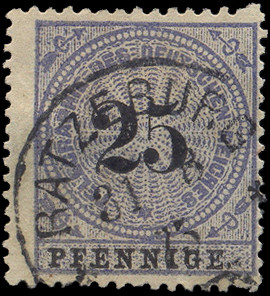
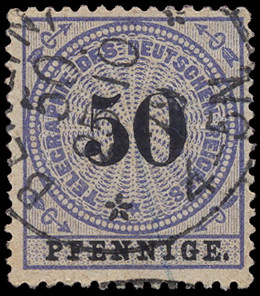
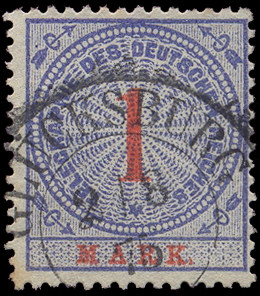
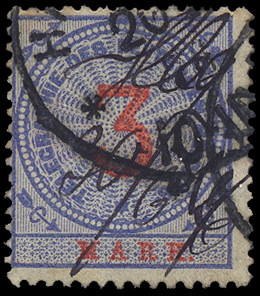
This issue was abolished in 1876, but I haven't seen a definite date. I think that existing stocks were simply used up without replacement as later dates can be found.
The 50 pfennige above (used in Berlin) is dated 1879. Examples again courtesy of Rolf Lamprecht.
| Hisc. | Description | Mint | Used |
|---|---|---|---|
| H9 | 3 Pfg blue (shades) and black | 16.00 | 3.00 |
| H10 | 5 Pfg blue (shades) and black | 4.00 | 1.50 |
| H11 | 10 Pfg blue (shades) and black | 5.00 | 1.50 |
| H12 | 25 Pfg blue (shades) and black | 5.00 | 0.60 |
| H13 | 40 Pfg blue (shades) and black | 8.00 | 2.00 |
| H14 | 50 Pfg blue (shades) and black | 4.00 | 0.50 |
| H15 | 80 Pfg blue (shades) and black | 10.00 | 1.50 |
| H16 | 1M blue (shades) and red | 4.00 | 1.20 |
| H17 | 2M blue (shades) and red | 8.00 | 2.00 |
| H17a | 'I' for 'K' in 'MARK' | 30.00 | 20.00 |
| H18 | 3M blue (shades) and red | 30.00 | 8.00 |
These seem prone to damaged lettering.
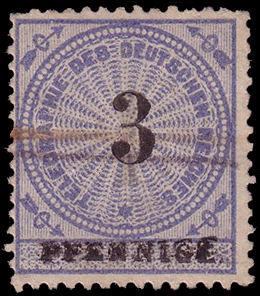 |
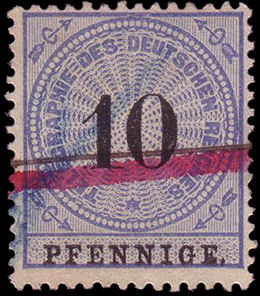 |
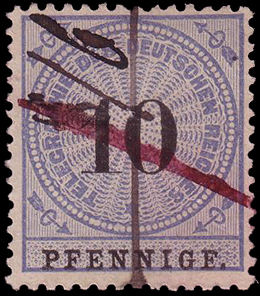 |
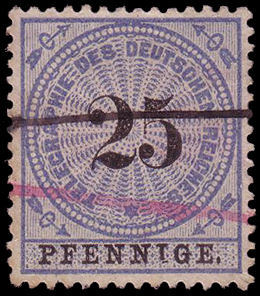 |
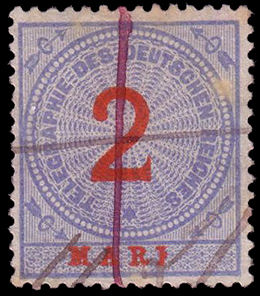 |
| H9 - 3 Pfennige with doubled letters. | H11 - 10 Pfennige with damaged last 'E'. | H11 - 10 Pfennige with 'F' for last 'E'. | H12 - 25 Pfennige with 'T' for 'I'. | H17 - 2 Mark, this is H17a listed by Hiscocks. |
Apart from the last, I do not know if these are constant varieties.
It seems likely that there are similar varieties with the earlier 1872 Groschen series.
These examples are courtesy of Rolf Lamprecht.
I would like to hear from anyone with these or other examples of damaged lettering.
Hiscocks added the following 2 notes:
| Note 1. The above issues are very similar to those of the North German Confederation (q.v.) at first sight and care should be taken. |
| Note 2. Both of the above issues were also used for postal purposes and may be found with normal postal c.d.s. cancellations. Telegraphic cancellations normally consist of pen strokes or crosses in both black and red on each stamp. Used prices above are for telegraphically used specimens and postally used are normally priced at about 3 x the above prices in catalogues covering postage stamps. |
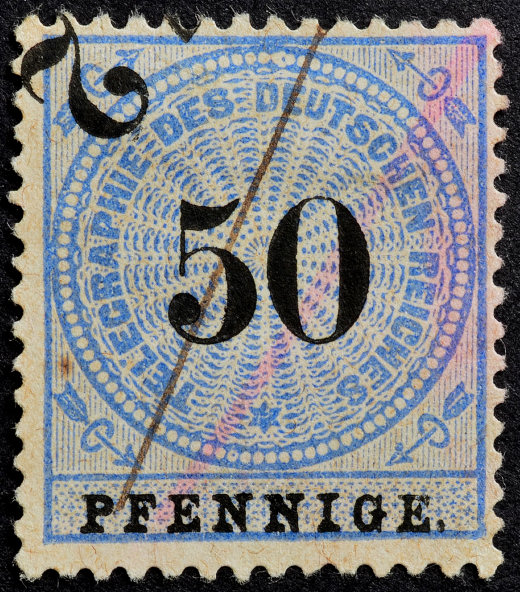 |
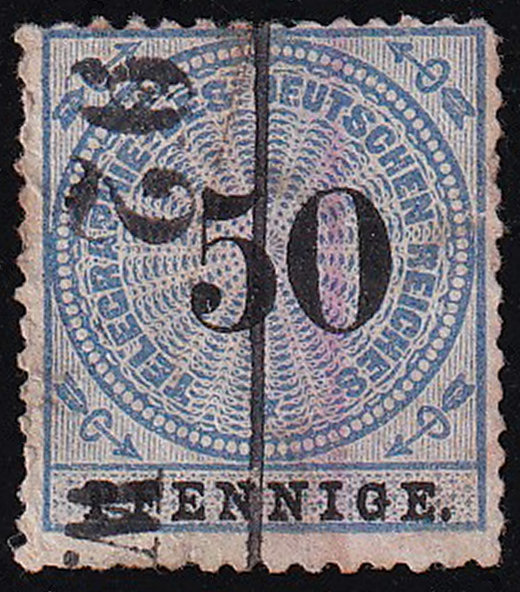 |
| H14 — courtesy of Mustafa Kocabasi. This has what looks like '72' (or '32') diagonally across the top-left corner. |
H14 — courtesy of Rolf Lamprecht. The "2" on this is the same style and size as that on the left, though with less contrast. It is preceded by a "9" and followed by "W." |
In the first image (taken with a camera), the "2" has about the same density as the value and was thought to have been similarly printed on the stamp.
The new (scanned) image shows that it was probably stamped on the telegram. It is interesting that these are both on a 50pf stamp. The markings may be indicative of the area or office.
Does anyone have further information or have similar examples ?
Telegraphic use of postage stamps.
There are a number of recognisably telegraphic cancels that were subsequently used.
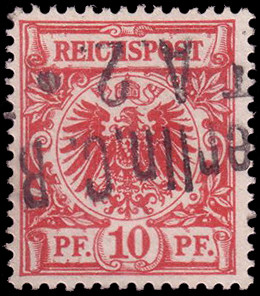
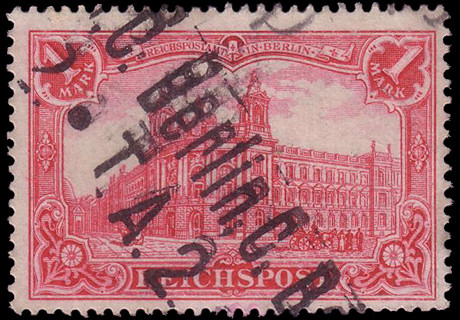
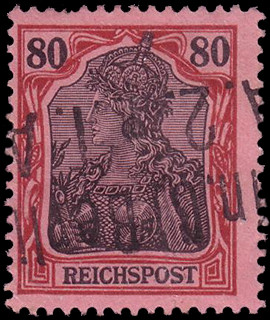
Berlin,C / T. A. 2. appears to be a roller cancel for central Berlin. I presume there is also a T. A. 1. at least.
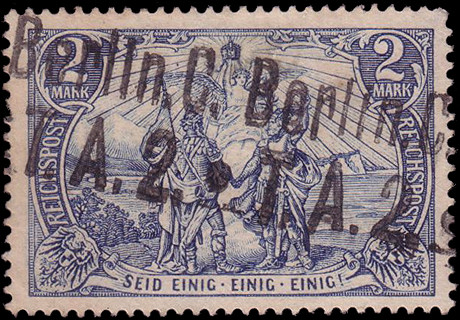
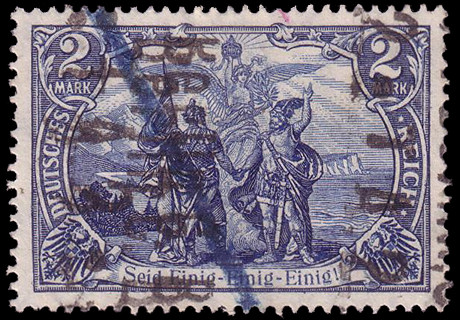
These seem to span from the 1890's to 1902 or so. Images courtesy of Rolf Lamprecht.
Berlin, West (I presume) of 1910. H. T. A. I take to be Haupt Telegraphen Amt or Main Telegraph Office.
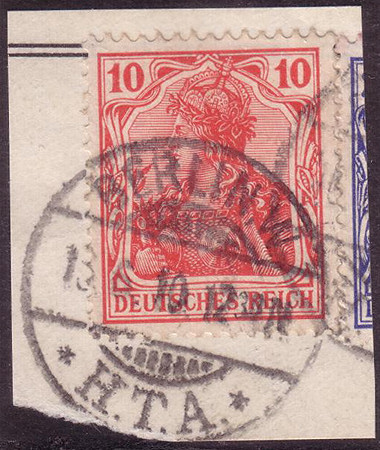
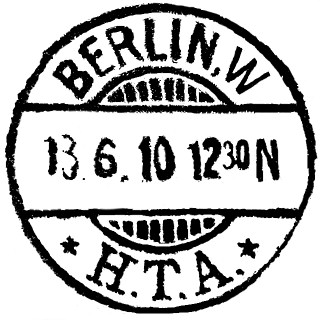
Image courtesy of Rolf Lamprecht, together with my attempt at a rendition of the cancel.
Stuttgart Telegraph cancels
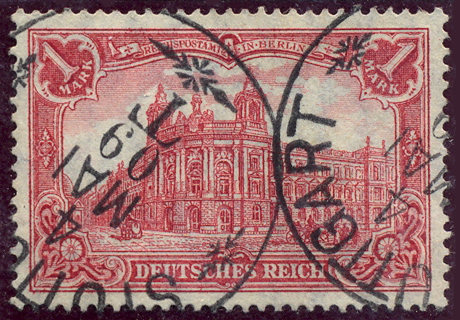
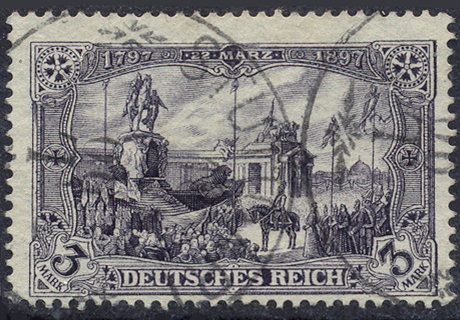
Courtesy of Rolf Lamprecht.
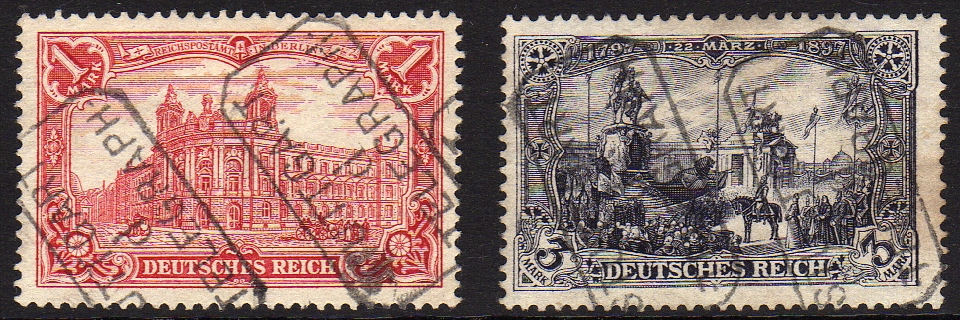
Courtesy of Andrew Higson.
Punched German postage stamps of Bergen, Vogtland. 1914.
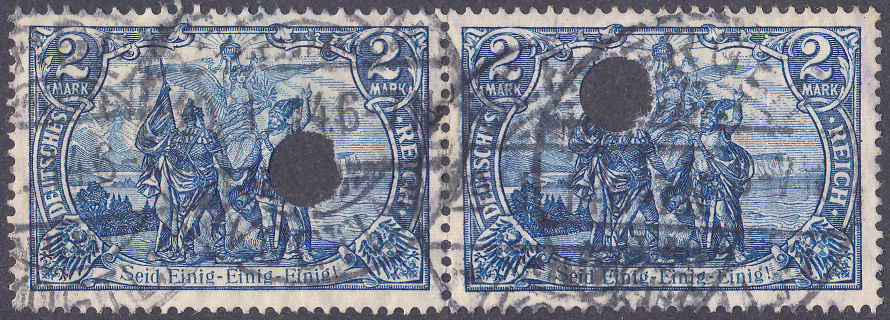
I initially thought that these were telegraphic, but apparently 'Paketkartens' parcel receipt with high value stamps were treated like this.
Telegraphendirektion Warschau cancels on 'Russisch-Polen' overprinted stamps for use in Russian Poland from 12 May 1915.
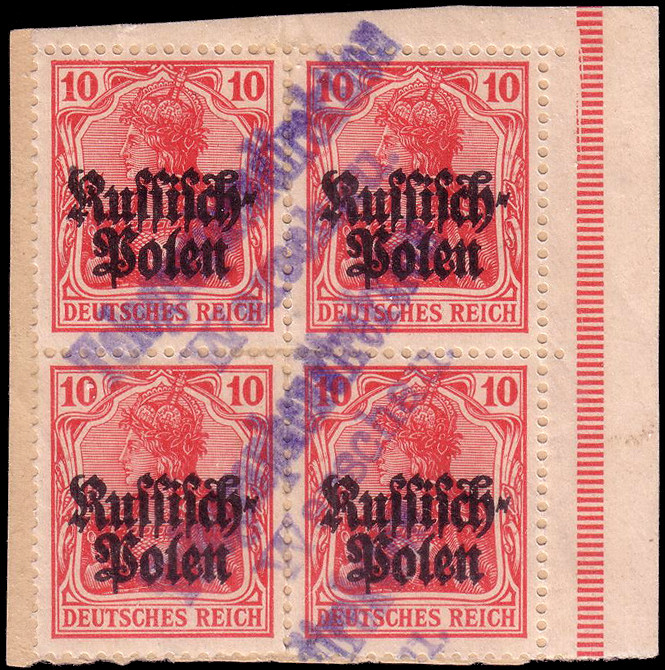
Image courtesy of Rolf Lamprecht.
El. - Telegr. - Dir.
Briefstempel
4. Armee
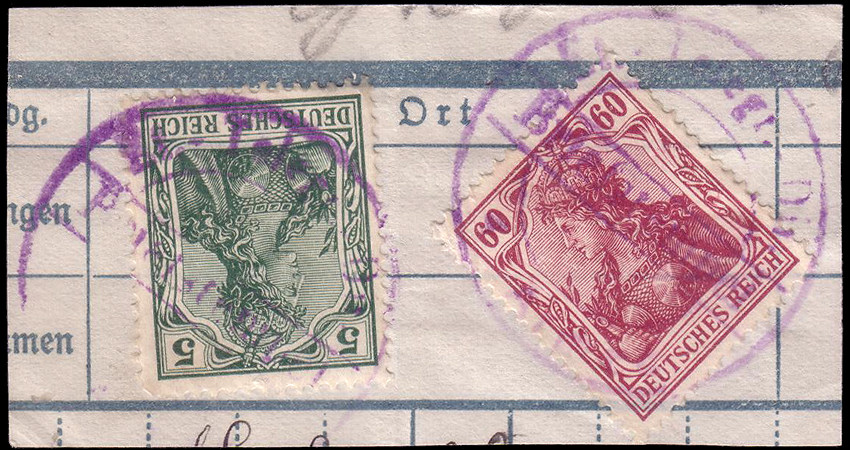
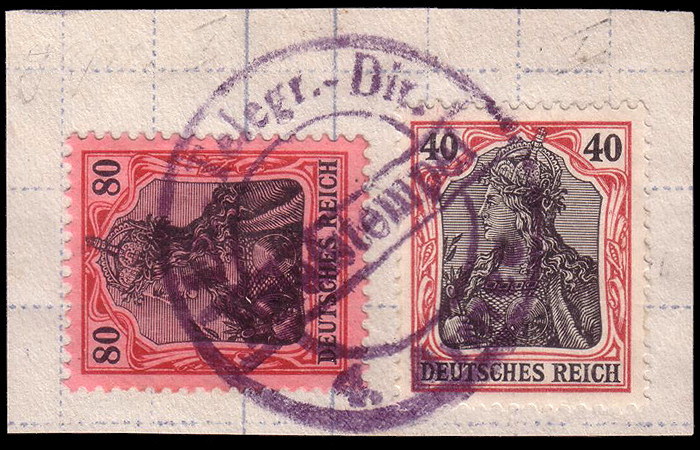
1915 - 1918 ??? - Image courtesy of Rolf Lamprecht.
S. B.
Telegraphendirektion
für 7. Armee
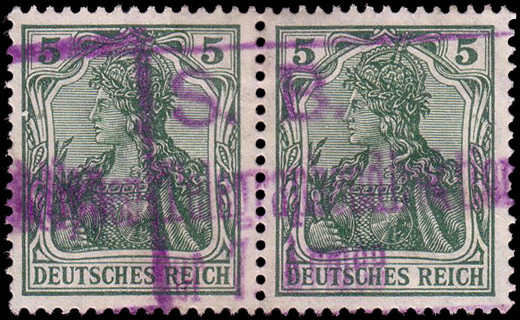
Image courtesy of Rolf Lamprecht who says this is for Belgium Etappengebiet West
(Staging area West).
II. Telephone Stamps.
1881(?) On plain pink paper. No watermark. Corners perforated for removal in use. No controls.
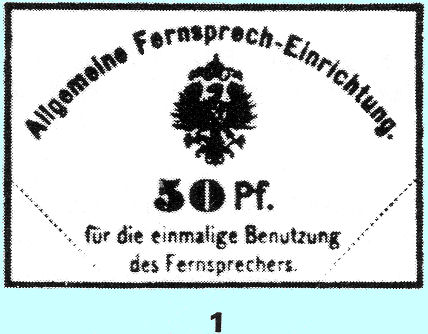
taken from pages 126 of Hiscocks book.
| Hisc. | Description | Mint | Used |
|---|---|---|---|
| H1 | 50Pfg black / pink | 40.00 | 30.00 |
| H1a | on "mixed/fibrous" paper | 40.00 | 30.00 |
| H2 | 75Pfg black / pink | 80.00 | 60.00 |
Hiscocks added the following note:
| Note. The illustration is not 2/3 actual size which is reported as 57mm x 40mm. The stamps were in sheets of 12 (3x4). |
1887(?) New design on white wove paper. No watermark. Corners perforated for removal in use. Controls in black.
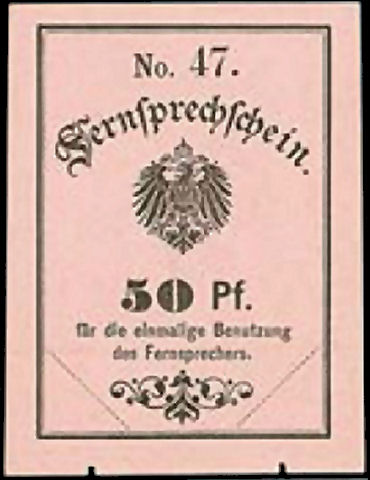
H4 - Courtesy of Spink and Son.
| Hisc. | Description | Mint | Used |
|---|---|---|---|
| H3 | 25Pfg grey-blue | 80.00 | 60.00 |
| H4 | 50Pfg rose | 80.00 | 60.00 |
Hiscocks added the following note:
| Note. Actual size 47mm x 62mm. |
1889 As above but design of German eagle changed (wings hanging down).
| Hisc. | Description | Mint | Used |
|---|---|---|---|
| H5 | 25Pfg light green | 80.00 | 60.00 |
| H6 | 50Pfg rose | 80.00 | 60.00 |
Hiscocks added the following note:
| Note. Nos. 3-6 were issued in sheets of 100 with control numbers 1-100. The use of these stamps ceased in 1891. |
Telegraph Seals.
A range of different seals were used on German telegrams at different times.
This half sized image shows a sample of them.
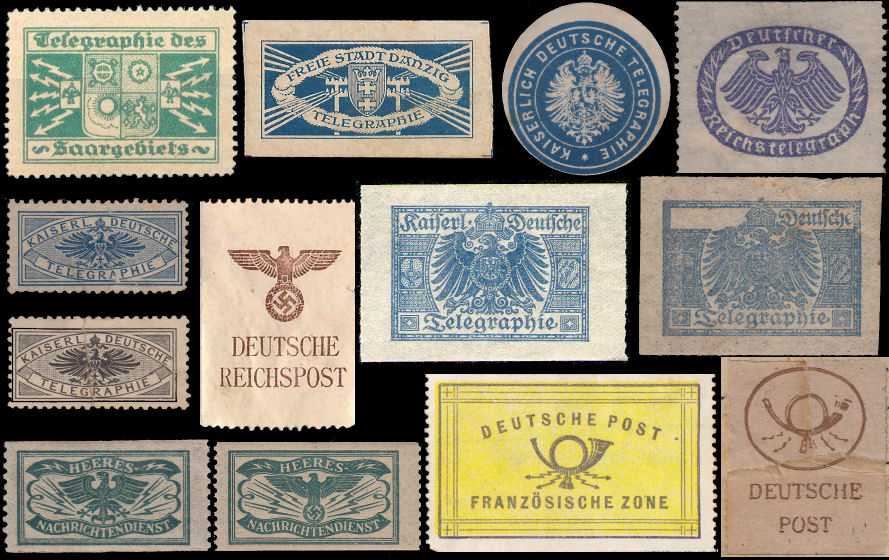
Steve Hiscocks made a start on cataloguing seals of the world in a book he published in 2007.
It was his hope to update it later, but unfortunately that was not to be.
His original book can be viewed at
Telegraph Seals: A World Catalogue. There are links from the pages to my updates.
Alternatively you can view the latest page for Germany which also shows a range of telegrams used.
